Archived Blog Posts
Preparation Tips for Winter Storm Season
5/24/2022 (Permalink)
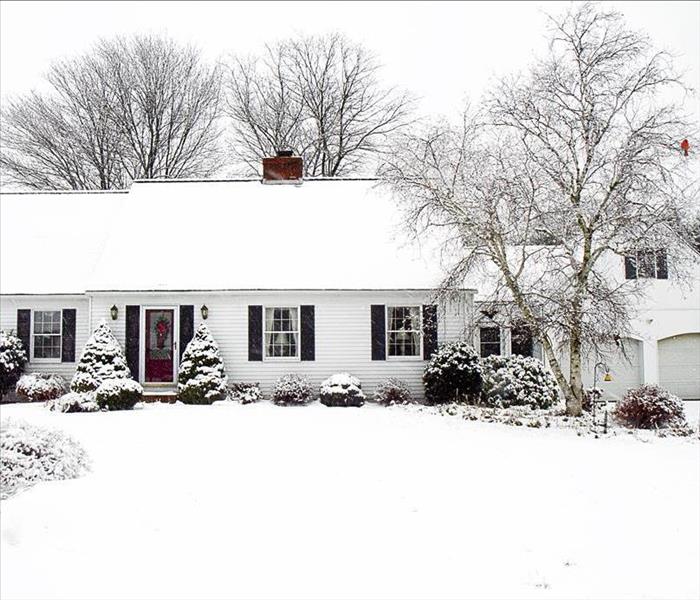 Be ready for Winter Storms by Following our Tips.
Be ready for Winter Storms by Following our Tips.
Caring for your home in Clearfield, UT, is a year-round job. You probably have an ongoing list of tasks to keep up with regular maintenance as well as specific projects and upgrades you want to make. As winter storm season approaches, there are a few things you need to add to your checklist to make sure your house is ready to brace itself against the changes in the weather.
Be ready for Winter Storms
Roof Damage Prevention
Your roof is one of the main protections your home has against the elements. It is a fundamental part of the building envelope that keeps your interiors dry. While it's important to keep the roof in good shape throughout the year, it's especially vital to ensure there are no weak spots or unnecessary pressure on it during the winter.
There are several ways to prevent roof damage during the winter:
- Clean debris out of gutters and downspouts
- Have the roof inspected for loose shingles or joints
- Test for air leaks that can lead to ice buildup
- Keep trees and shrubs trimmed to minimize the threat of damage during a storm
Pipe Protection
One of the most common causes of water loss in residential properties, particularly during a winter storm, is a pipe break. If your plumbing isn't properly insulated, the pipes can freeze and burst. Any water that is in them then gushes into the surrounding space.
To prevent this from happening, water damage mitigation experts recommend that you insulate your pipes and maintain a constant warm temperature in your home. It's also a good idea to keep cabinets open during a hard freeze so that warm air can flow more freely to the pipes inside them.
Energy Conservation
Higher utility costs are often a challenge for homeowners during colder months. At first glance, the spike may seem normal, as the heating system must work harder to combat the freezing temperatures of the latest blizzard and keep your home's interior warm. The change in weather may not be the only thing driving up the electric and gas bills, though.
Warm air escapes to the outside by any means necessary. Check the seals around your windows and doors to ensure that there are no leaks. The more you can keep the warmer air inside where it belongs, the lower your utility costs are likely to be.
Emergency Preparation
Finally, you need to plan for dire emergencies. No matter how well you maintain your home, a blackout may occur at some point during the winter. A backup generator can keep your lights on and the heater running, and a sump pump in the basement can get rid of standing water if a pipe break or groundwater incident occurs. Always keep shelf-stable food, first aid kits, batteries, flashlights, bottled water and sanitation supplies stocked and easy to access.
Your home maintenance checklist is something you need to pay attention to all year. If a winter storm is on its way, though, there are a few extra tasks you may need to add to it. Staying weather aware and prepared protects your home and everyone in it.
How SERVPRO's Claims Inventory System Helps Insurance Agents and Their Clients
5/23/2022 (Permalink)
 Learn More about our Claims Inventory System. For more information, just contact us.
Learn More about our Claims Inventory System. For more information, just contact us.
As an insurance agent in Clearfield, UT, you often deal with customers who are stressed. They may fear that some of their valuable documents have been destroyed by a flood or fire. They may also wonder if they will be able to re-open their businesses.
Filing an insurance claim can be a great hassle, as well. It is your job to alleviate this stress. You can do that by choosing a vendor such as SERVPRO that has a claims inventory system. This system allows you to easily track various claims.
Benefits of the SERVPRO Claims Inventory Service
1. Information Access
When processing a client’s claim, you will need quick access to relevant information, such as the costs of certain items. The claims inventory system allows you and your client to find important documents promptly. This will make it easier for you and your client to work together during the restoration.
2. Organization
Your client will have to provide a lot of paperwork when he files his claim. There will be numerous receipts and photographs that can easily get lost. The claims inventory service keeps all these documents in one place for better organization.
3. Expedited Process
The longer you take to process the insurance claim, the more frustrated your client will be. The property may also suffer additional damage during the delay, which will make the restoration last longer and the claim more expensive. However, if all the important information is accessible and organized, you will be able to finalize the claim more quickly. This should lead to more satisfied customers.
Other Benefits
It is not just the claims inventory system that sets this company apart from the rest. The company also has a separate National Accounts Division that manages relationships with insurance providers. This ensures that the cleanup experts and the insurers are all on the same page. There should be communication and transparency throughout the restoration process.
You and your clients can also trust that the remediation will be done promptly and according to Institute of Inspection Cleaning and Restoration Certification standards. This reduces each claim’s costs and makes your customers happier.
The company additionally uses internal audits to check for quality. It also hires workers who are trustworthy. Even temporary employees are subjected to background checks.
Employees are given the opportunity for continued training, as well. In fact, the business opened its own training facility in 1992. The company offers training for new franchisees and an employee certification program. The company is also an approved training school for the IICRC that provides classes on a variety of topics, including applied structural drying. There are even continuing education courses for real estate and insurance professionals. These classes cover emergency mitigation procedures.
When a client files an insurance claim, it should be easy for you to access the information about the property. Your client, meanwhile, will want the claim to be processed as quickly as possible. A claims inventory system can expedite the claim and keep all the required documents organized. When choosing an emergency restoration vendor, you should thus look for one that offers this service.
5 Key Components of a Fire Escape Plan
5/12/2022 (Permalink)
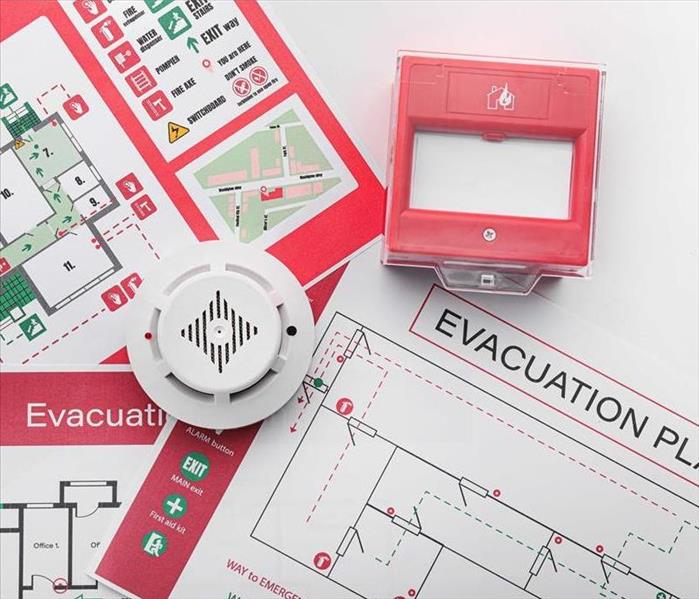 Develop a Good Fire Escape Plan by Following our Tips.
Develop a Good Fire Escape Plan by Following our Tips.
Knowing that there are an estimated 100,000 commercial property fires a year, it’s vital that businesses in Clearfield, UT, plan for the unexpected. While a commercial fire restoration company will be able to take care of the property, business owners need a well-thought-out fire escape plan to ensure everyone on the property is safe. When developing a plan, below are five steps to take.
Key Components of a Fire Escape Plan
1. Identify Potential Hazards
The first step is determining the potential risks to your business. Is there a kitchen? Are portable space heaters used? Are extension cords over their limit? Take a tour of the facility and look for areas that may create added risk. Once those are discovered, come up with a solution for each and communicate any cooking or heating rules to everyone onsite.
2. Map Escape Routes
A fire escape plan is essential to a successful evacuation. A map should be created of the facility, including primary and alternate escape routes. When creating the map, ensure you take into consideration any employees who may have special needs. Once the best route is determined, ensure that the path is always clear of any obstacles, such as furniture. The mapped plan should be posted throughout the facility to ensure that it is easy to see if a fire does break out.
3. Assign Roles
Dealing with a fire is a chaotic situation. Even if people know where to go, there may easily be confusion and added stress. As part of the evacuation plan, specific roles should be assigned to specific individuals to assist in an emergency situation. This may include a chief fire warden, who holds responsibility for the overall event and planning, as well as an assistant to help alert employees.
For larger businesses, consider assigning people as route guides to assist people as they exit via the designated escape route and others as point personnel for using the fire extinguishers.
4. Develop a Communication Plan
While the first thoughts may be on the fire itself, it has the potential to affect other people. Staying in communication with clients and employees’ relatives is essential. Prepare a list of essential contacts, including local hospitals, clients, suppliers and employee contacts. This list should be easily accessible to the fire warden or assistant to help deal with the aftermath of the fire.
5. Practice the Emergency Escape Plan
Even if you have the best plan of action, you still need to ensure it works by having regular drills. Along with reinforcing confidence in your designated fire team, it provides everyone onsite with added peace of mind that they have practiced evacuating the building and will be ready for the real situation. After each drill, the team is more easily able to address potential issues that may arise or make changes to the overall plan for added safety measures. These drills also reinforce how important employees are to the business.
No matter how small a business is, it should always have a fire escape plan. Ensuring that everyone knows what to do and where to go increases the chances of a safe evacuation.
When Is a Flooded Basement Covered by Insurance
4/21/2022 (Permalink)
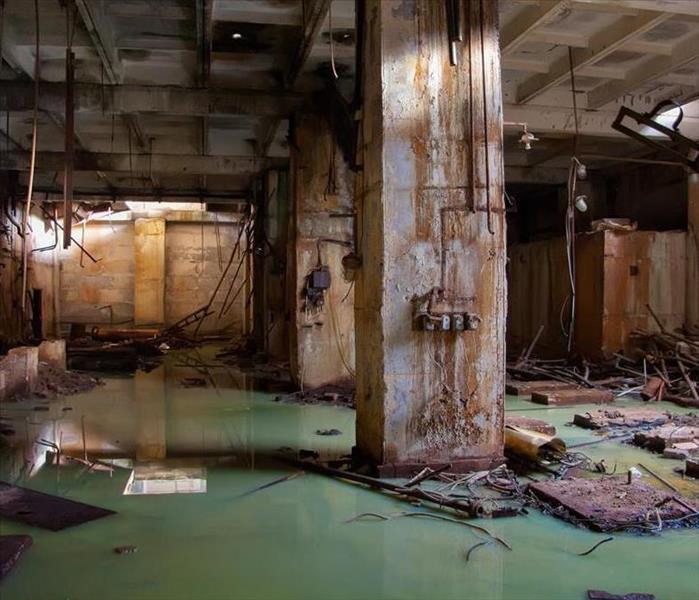 Learn when your Flooded Basement is Covered by Insurance by following these tips.
Learn when your Flooded Basement is Covered by Insurance by following these tips.
Did you walk downstairs to find a basement flood? You may stare in wonderment, questioning what your next move should be and whether insurance can help you recover from this damp, extensive situation. Your insurer may assist. However, rest assured there is someone to stand by your side. SERVO restoration professionals in Clearfield, UT, react swiftly within 24 hours to deliver prompt attention and aid.
Our team cleans up and informs while you work with insurance to determine if the basement's damage is covered. That leaves you time to work through a claim. The following are times when your insurer may or may not deem the flood under the policy.
1. How Did the Basement Flood?
Most insurance policies do not cover floods. This coverage requires a separate policy or add-on clause, especially for those living within flood-prone zones. General liability and property insurance claim does not handle it. However, there are exceptions to the rule. Insurers focus on water sources and maintenance.
For instance, a flood centers on water masses, leaving a larger body such as an ocean, lake or river. When these overflow and push water into a residence, the insurer will likely deny the claim. In these circumstances, the water enters from the ground level.
However, insurance agents can view basement flooding as secondary damage, harm caused by something else. For instance, did the puddles appear because of a bad septic tank, broken pipe or leaking water heater? These events triggered water damage. The water came from above the floor, saturating it because of a faulty part or device. In these cases, the agent may approve a claim.
A water remediation team can assess the source, documenting the origin and secondary effects. This information may prove helpful in conversations with the agency, determining approval for insurance coverage.
2. Homeowners Were Not Aware of a Problem
Did you know the source existed? For instance, some owners may consider a leak minor, choosing to handle it down the road. However, this choice could jeopardize the claim. The agent needs to know that it has happened quickly and without the owner knowing the potential for trouble.
Water heaters can face buildup and corrosion, eventually leading to significant breaks and flooded rooms. This negligence could open questions about whether homeowners knew the device's weakness. It's essential to prove through an inspection that the breach could not have been prevented and that the owners had no knowledge of its existence.
3. You Continue To Maintain Inspections and Repairs
Ready yourself to validate your attention to plumbing maintenance and repairs. The insurer may ask when you last had it inspected or repaired. It's best to continue regular checkups on water lines and units. If something goes wrong, owners may show the receipts and invoices as documentation of routine care. This reasonable faith effort could help gain approval.
Insurance might help with your basement flood. It depends on where the water came from and how well owners can prove it was accidental and quick. Throughout this process, rely on SERVO franchise experts to assist in the cleanup and document the event for you.
7 Reasons To Use Security Fencing After a Fire
4/13/2022 (Permalink)
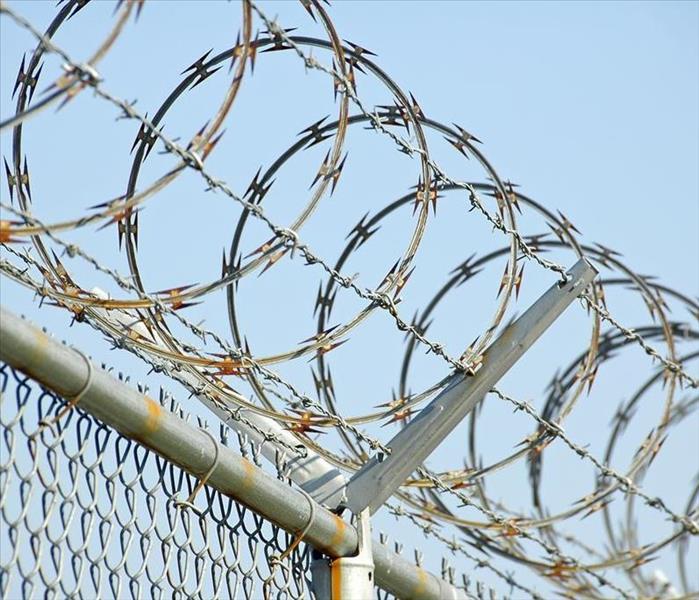 Security Fences can be really useful To Avoid Damage in your Property.
Security Fences can be really useful To Avoid Damage in your Property.
Many businesses use a security fence to protect employees and property from intruders. A fire-damaged building may be a particularly attractive target to thieves or vandals because some of the normal defenses may be gone and the building may be unoccupied. There are multiple benefits to using a fence to protect your fire-damaged building.
Benefits of Damage Security for Fire-Damaged Buildings
Unfortunately, looting can often be a problem in the wake of a fire. It is important to take steps to protect your property from looters, thieves and vandals.
1. Deters Crime
Most thieves and vandals prefer an easy target. A building that is surrounded by a strong, difficult-to-climb fence does not look like an easy target.
2. Is Customizable
Different types of businesses require different types of fences. You can choose from chain link, palisade or wire mesh. Chain link is attached to sturdy posts and is difficult to cut. You have the option of adding barbed wire to the top to make it more difficult to climb. Palisade fencing is made from rigid, steel posts with pointed tips at the top. This type of fencing is very sturdy and difficult to climb and may be more attractive than chain link. However, it is usually more expensive. Garrison fencing is constructed from welded tubular panels.
It is more attractive than chain link, but not as strong as palisade. Wire mesh is less expensive and easier to install than chain link, but more easily cut. It may be a good option for temporary fencing because of its lower cost.
3. Controls Access
Putting up a security fence makes it easier to control who is coming on your property. This can be particularly useful while cleanup and repairs are ongoing. You may have a variety of people, such as a fire remediation company crew, on your property who normally wouldn't be there. A fence helps you make sure criminals don't slip in undetected amongst the cleanup and repair workers.
4. Saves Money
There are other ways to protect your property, such as installing security cameras, alarms and entry control systems. However, these methods can be expensive. Fences are a relatively low-cost way to protect your property.
5. Is Easy To Maintain
Professionally installed fencing does not need regular maintenance and should last for years. Other types of security technology must be updated regularly and replaced as it becomes obsolete.
6. Provides Proactive Protection
Many types of security equipment, such as alarms, work by alerting you when an intruder is already on your property. A fence can keep an intruder from getting on your property in the first place.
7. Improves Your Security Permanently
A high-quality fence can last you many years. Having a professional installer in Clearfield, UT, put up a fence on your property not only provides protection while you are repairing your building but improves your security once the building is restored.
Adding a security fence to your fire-damaged property provides many benefits. It helps keep looters, thieves and vandals away from your building during the repair process and can be a permanent improvement to your building security.
Working To Save Your Carpet After a Pipe Break
4/9/2022 (Permalink)
 Follow these Tips and Save Your Carpet After a Pipe Break.
Follow these Tips and Save Your Carpet After a Pipe Break.
If your home in Clearfield, UT, experiences a pipe break, you will have a lot to think about. Among your first concerns will be what in the home is salvageable and what will need to be thrown out. This often means worrying about your carpeting since it is on the floor and is more likely to get wet than anything else. At this time, you will also need to consider the condition of the materials beneath the carpeting, namely the padding.
In a few cases, you will be fortunate and will be able to save your carpeting. If the following conditions exist, your carpet is likely to be clean enough to keep in your home:
- The leaked water is from a clean source
- The leak was discovered quickly
- The carpeting and underlying pad can be dried professionally
- The carpeting is relatively new and in good shape
It is important to understand that each water leak is unique and situational. An experienced water damage repair company is often your best source of information in these circumstances, especially if you wish to keep your expenses to a minimum.
A More Complicated Pipe Break
A Category 1 water leak involves water from a clean source such as drinking water or unused cleaning water. Even with this situation to save many items you have only 24-48 hours to remove the water and dry out items such as clothing and furniture. The most effective water restoration plan is quick and accomplished with industrial vacuums and dryers.
A Category 2 water leak is a bit more serious and usually involves water that is mildly tainted with non-hazardous debris. This is something like the overflow from dishwashers or washing machines. If caught early enough, your carpeting might be salvageable with this leak, but the padding will likely have to be replaced.
A Category 3 leak is anything that involves hazardous materials, black water or water that has been standing for more than two or three days. Some examples of this category of water include the following:
- Overflowing toilets with solid matter
- Floods from exterior sources
- Sewage water
- Stagnant water from any source
Almost anything that comes in touch with the dirtiest water will need to be replaced. Even if an item seems as though it has been cleaned well enough, it still could contain pathogens and other nasty elements, making it safer and healthier to replace.
A Smart Course of Action
If you experience water in your home, it is important to keep safety first and foremost. If you are unsure of the cleanliness of the water, keep children, small pets and anyone else away from the water.
Make sure there are no electrical wires or outlets that could pose a danger to anyone. Watch out for hidden dangers if the water is opaque as it could be hiding obstacles or even small animals such as snakes or rats.
A pipe break in your home is never fun. With the right course of action, you can keep your expenses down and make sure your home remains a healthy place.
Insurance Coverage Tips for Mold Remediation
3/21/2022 (Permalink)
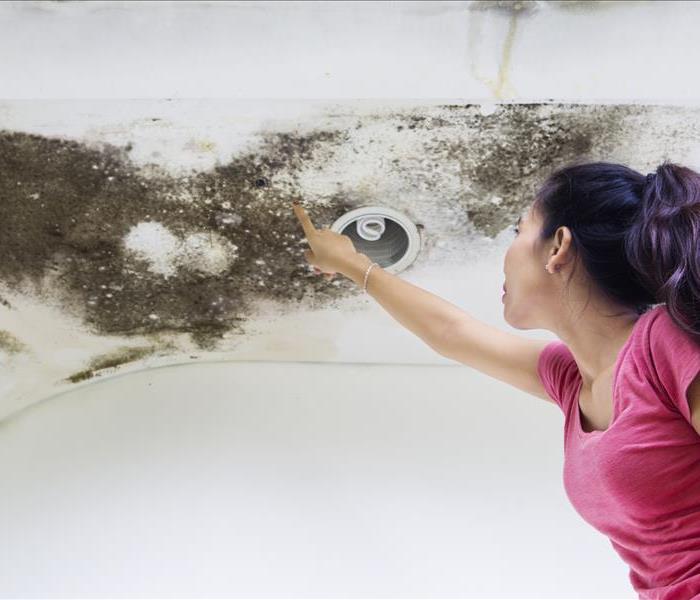 Know more about Mold Insurance Coverage by Following These Tips.
Know more about Mold Insurance Coverage by Following These Tips.
If you smell a musty odor as you walk through the front door of your home in Clearfield, UT, it may be a sign that you have a mold problem. Fungus growth not only can be difficult to get rid of but also may cost you a lot of money by the time mitigation is done.
To further complicate matters, many homeowners' insurance policies don't fully cover mold remediation. Here are some tips on how to proceed if you suspect you have a problem.
Know Your Homeowners' Insurance Limits on Fungus Growth
One reason that it is so difficult to find a home insurance policy with mold coverage is that most growth stems from long-term water damage that has not been mitigated. To your provider, this comes across as negligence, because regular inspections and maintenance can help you avoid such a problem. Most homeowners' insurance policies only cover mold that directly results from a covered peril:
- Fire prevention measures
- Sudden and hidden attic leaks
- Extensive flooding from a pipe break
Some homeowners' policies specifically exclude mold in their coverage. This is especially common for those who live in humid areas or who have homes made from materials that are particularly vulnerable to fungus growth. If either of those factors applies to your home, it may be very difficult to file a successful claim to cover any mold remediation.
Use Detailed Reporting To Maximize Your Policy's Limits
A mold provision in your policy may only cover mitigation up to a certain dollar amount. To ensure that you are getting the most out of your coverage, be careful how you list the specific mitigation steps on your claim. Even if you have mold insurance, vague reports can use up your mold damage remediation limit in a hurry.
For example, waterlogged drywall will need to be removed and replaced regardless of whether it has mold growth on it. There may be an additional surcharge if fungus remediation is included in that process, but only the additional amount should be included under the mold clause of your policy. Make sure your claim reflects not only the tasks you're being charged for but also the specific reason for each itemized expense.
Take the Appropriate Steps To Remedy the Problem
Upon discovery of a fungus issue in your home, you should take a few immediate steps. First, call mold damage mitigation experts to get the cleanup process started as quickly as possible. Next, try to contain the affected area so that the spores don't spread. Close doors and other airways to block it off from the rest of the house. Turn off your HVAC unit or close the vents to the room to further seal it off.
It may be tempting to try to clean the moldy area yourself, but it's better to wait for the professionals. If you do anything to disturb the patch of fungus growth, you may make the problem worse. Leave it alone and wait for the technicians to arrive and assess the damage.
Mold damage to your home can be expensive to mitigate, and there's no guarantee that your homeowners' insurance will cover it. Understanding your policy and knowing the best way to deal with damage will help you minimize your out-of-pocket costs.
5 Factors To Consider When Installing Fire Alarms In Your Home
3/14/2022 (Permalink)
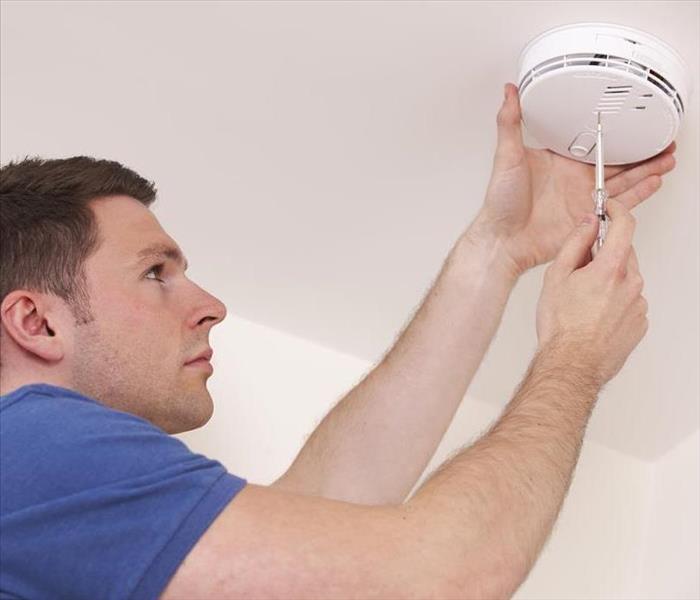 Installing Fire Alarms In Your Home can be Easier if you Follow These 5 Tips.
Installing Fire Alarms In Your Home can be Easier if you Follow These 5 Tips.
When you move into a new home in Clearfield, UT, there is so much to think about. How will each room be set up? What paint colors will you choose? One thing many new home owners forget to do is install a fire alarm. While you might not be thinking about your safety plan in the first few weeks of homeownership, it's an important step to take to keep your family safe.
Here are five factors to consider when installing fire alarms in your home.
5 Key Factors to Consider as regards Fire Alarms
1. Why Should I Install Fire Alarms?
Some people think that they don't need alarms in their homes. Maybe because the home is small, they think they'll notice any emergency. Some think that because they are light sleepers, they would smell smoke and have time to evacuate. Home fires can occur when you're not home, and even the most safety conscious person can have an accident.
Fire alarms save lives and prevent smoke damage to your belongings. If a fire does occur, an emergency restoration service can help repair your home.
2. How Many Floors Does My Home Have?
At an absolute minimum, you need to have one smoke detector on each floor of your home. If you have a basement, a main floor, and an upstairs, you need at least three alarms. The more square feet you have, the more alarms you need. In a small home, like an apartment, it may be sufficient to have one alarm near the bedrooms and one in the kitchen.
In a larger home, you want to be sure that an alarm can be heard not matter where a person is, so it would be important to put multiple alarms on each floor to keep everyone safe.
3. Where Should I Install a Fire Alarm?
The National Fire Protection Association recommends a fire alarm in each sleeping room and one outside the room. If you have two bedrooms upstairs, two on the main floor, and one in the basement, you should have at least eight alarms in your home.
4. What Type of Alarm Should I Install?
There are many brands of fire alarms to choose from. An alarm should detect smoke and carbon monoxide, but many can alert you to other problems too, like increased temperature. Alarms can be battery-operated or wired into the home.
Ideally, all alarms should be connected to one another so that when one sounds, all alarms sound. That ensures that everyone will know that there is an emergency.
5. How Often Do I Need to Check My Alarms?
Test your smoke alarms once a month. You're more likely to notice a low battery indicator or a problem in wiring when you check them often. Change the batteries when you change your clocks. When you move into a new home, replace the smoke detectors unless the seller told you when they did it. Otherwise, replace the alarms every ten years.
Moving to a new home is exciting and stressful. Take one stress off your plate and install smoke detectors all around your home to prevent fire damage and to keep your family safe.
Keep Business, Employees Before and After a Severe Storm
3/9/2022 (Permalink)
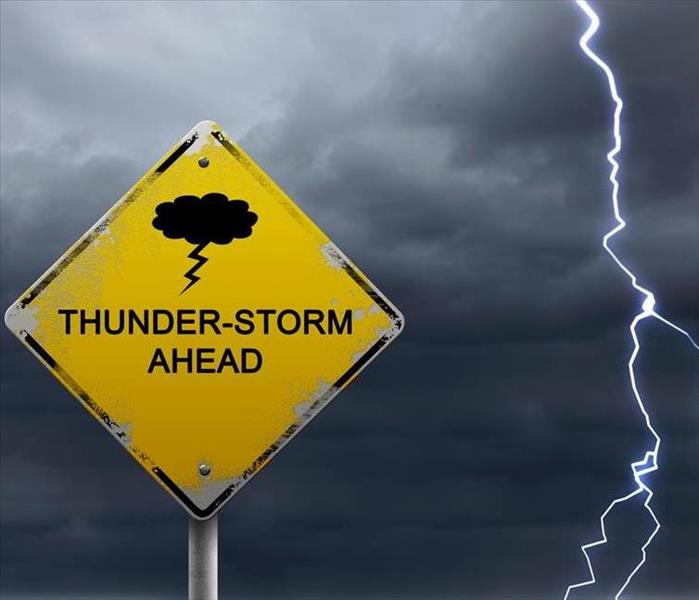 Be ready for Severe Storms by Following These Tips. If you have more questions, just contact us.
Be ready for Severe Storms by Following These Tips. If you have more questions, just contact us.
Severe weather may happen anytime in Clearfield, UT. For businesses, protecting assets and employees means being prepared prior to the rain storm arriving. Once the bad weather hits, it's vital to follow recommended safety precautions to minimize risk.
Building Maintenance Before a Storm
From high winds to lightning strikes, a building takes a beating during harsh weather. While it may be easy to forget when the weather is nice, regular maintenance and repairs are vital to the structure withstanding Mother Nature’s wrath. Below are a few tips to help reinforce your property.
Roof Maintenance:
Regular inspections are needed regardless of what type of roof your building has. Even less severe weather may begin to cause damage that will quickly become much worse during a severe rain storm. If any leaks or visible damage is detected, get it repaired immediately to avoid the need for costly repairs.
Secure Windows and Doors:
One broken seal may mean excessive water getting into places it shouldn’t. Regularly inspect seals, caulking, hinges and other hardware to ensure that the building is secure. Any signs of warping or rusting are indicators that these features may be compromised.
Landscaping:
If your property has any trees, ensure they are trimmed to avoid a branch falling on the roof or bursting into a window. Regularly check that gutters are free of debris and properly draining. Along with adding an aesthetic, planting bushes and plants may help absorb some of the excess water from a storm.
Lightning Protection System:
If a bolt of lightning hits your structure, or even nearby, it may produce a surge of power that may turn into a power outage or cause a fire. Strong winds may also cut the power. A protection system is designed to help handle those surges, helping to keep business running as usual and preventing a fire from breaking out.
HVAC Protection:
Hail is a common product of a storm, which means your HVAC system may get damaged. There are hail mesh, shields and guards that can be installed to prevent that from happening. These added layers should also be regularly checked. Also, ensure that whichever you choose is properly installed to resist wind.
Follow Safety Guidelines During a Thunderstorm
As secure as the structure may be, severe weather still requires making the safety of everyone around a priority. To help protect employees and anyone else on-site, staying inside is essential. It is recommended that people stay indoors for a minimum of 30 minutes after thunder is heard.
Additional safety tips include:
- Ensure windows and doors are tightly shut.
- Do not use ungrounded electrical equipment, including televisions and radios that are not battery powered.
- Try staying in an area away from windows.
- Since lightning is able to travel through pipes, stay away from water.
- Minimize contact with concrete, which is reinforced with metal bars or wires.
A rain storm comes with much more than excessive moisture, all of which can cause damage to a building. By taking steps to ensure your building is secure, it makes weathering the bad weather easier and safer.
What To Expect During a Pipe Burst Cleanup Procedure
3/7/2022 (Permalink)
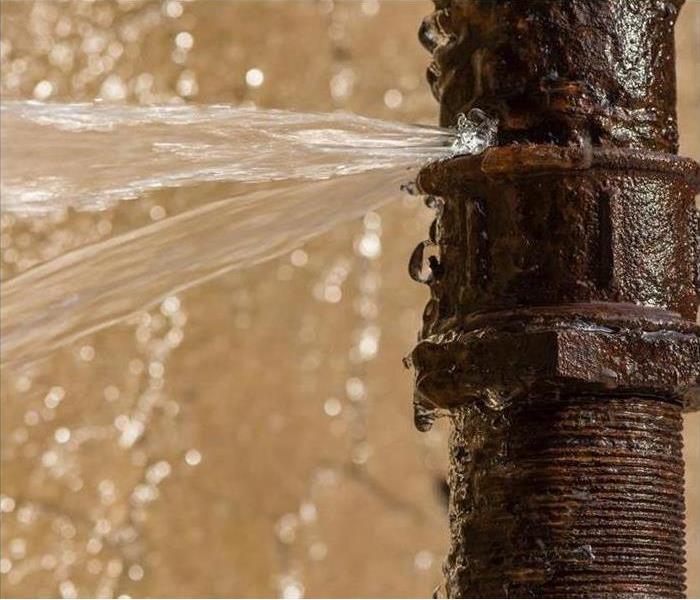 Learn more about what to expect during a Pipe Burst Cleanup by following these Tips.
Learn more about what to expect during a Pipe Burst Cleanup by following these Tips.
A leaking supply line or broken pipe can cause massive damage in a short amount of time. If you have never seen it before, you may wonder what happens during a pipe burst cleanup and repair.
Repair Pipe
The first thing any water mitigation company in Clearfield, UT, should do is repair any broken pipes or supply lines. No matter what, stopping the water is one of the most important things that they do. If you still have a pipe or supply line leaking, the damage will continue to grow. Make sure they repair the actual problem before they do any cleaning or rebuilding.
Extract Water
When your pipes are leaking, you can bet that there is water to be extracted. Even if you can't see it, there could be water behind or in your drywall, flooring or crawlspace. When the water gets into your carpet, it can start to smell bad. No one wants a musty-smelling business. Water extraction is a big part of any pipe burst cleanup.
Remove Damaged Items
Depending on what is damaged, sometimes a cleanup company will do this before they extract the water. They take out and dispose of all of the items that cannot be cleaned. The cleanup company should know the disposal rules for your area.
Dry the Area
They will then dry the area with chemicals or with fans. This process is time-consuming and should be done carefully. Leaving an area damp will cause more damage like mold and mildew. Developing mold or mildew can cause bad odors, among other things. A good water cleanup company will dry the affected areas thoroughly.
Sanitize and Deodorize
After the area is dry, it is time to sanitize everything and deodorize it. Your cleanup company will make sure that everything is prepped and ready for the repairs to begin.
When you are dealing with a pipe burst cleanup, it is helpful to know what will happen during the process. This helps you plan your business activities around the cleanup and repair process.
What Happens to Building Materials When They Get Wet?
3/7/2022 (Permalink)
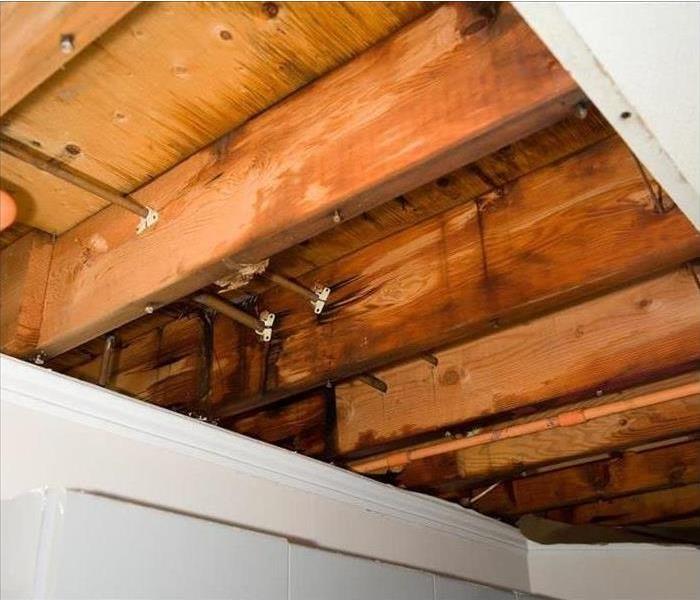 Follow these Tips and learn more about What Happens to Building Materials When They Get Wet.
Follow these Tips and learn more about What Happens to Building Materials When They Get Wet.
A home flood is nothing to take lightly. However, most people don't realize just how deep the waters can flow. No matter what type of water is infiltrating your home, swelling wood and wet drywall are just two types of potential underlying structural damage. Destruction will increase with every moment moisture lingers in the house.
It's vital to begin the remediation process as quickly as possible to avoid the following types of damage:
Types Of Damage Due to Flooding
- Drywall
Flooding will often damage drywall because it's a porous material and wicks the water up like a sponge. The drywall will then become frail or may even begin to crumble. If the entire wall hasn't suffered damage, you can cut out and replace only the affected areas.
- Insulation
Water-soaked drywall can easily lead to water-damaged insulation. You'll have to replace it, but only after work like water pipe repair has been completed and after the structure is dried thoroughly.
- Wood
Waterlogged wood immediately begins expanding. Swelling wood can create various problems that are at risk of affecting your home's structural integrity. If you notice cracking around your door jambs or have trouble closing some of your doors that used to shut easily, it's a sign that your house's frame is enduring an extreme amount of pressure. Ignoring the issue can eventually lead to severe foundation problems.
- Mold
Mold can begin growing within 24 hours of moisture exposure. Therefore, you must begin cleaning and drying the area immediately. If you suspect the water has been there for more than 24 hours, hiring water damage restoration specialists is highly recommended. They can investigate for mold and follow proper procedures for safe removal.
- Electrical Systems
Water can severely damage your electrical system. You may have outlets that don't work or ones that frequently short circuit. These problems can be a fire hazard, so it's crucial to get your electrical system inspected and repaired immediately.
If your Clearfield, UT, home floods, whether from a ruptured supply line or heavy rainfall, the resulting loss will essentially be the same. Specialists must inspect the home for damage such as swelling wood to ensure its structural integrity.
Common Causes of Basement Floods
2/23/2022 (Permalink)
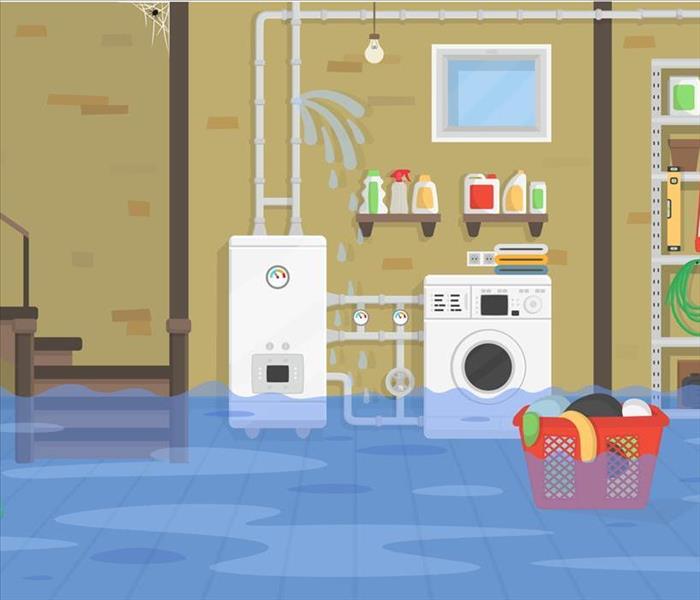 Follow these Tips to learn about Basement Floods and avoid Storm Damage in your Clearfield, UT property.
Follow these Tips to learn about Basement Floods and avoid Storm Damage in your Clearfield, UT property.
A storm in Clearfield, UT, can cause a lot of damage to your roof and other parts of your home. It may lead to a flooded basement, especially if there is a lot of precipitation involved. There are many ways floodwater can invade your home, and knowing the signs of potential issues may help you avoid this problem.
Surface Water Leaks
Water that pools on the ground can enter your home through even the smallest flaw in your foundation. There are many possible sources of surface water during a storm:
- Clogged gutters or downspouts
- Improperly positioned downspout
- Landscape sloping toward your home rather than away from it
- Broken pavement sealant
- Close-range irrigation system
If any of these issues exist near your home, it doesn't take a lot of water to cause a serious problem in your basement. Your first line of defense is doing everything in your power to direct the flow of water away from your home.
Groundwater Seepage
Light rainfall is typically absorbed into the soil or evaporates quickly enough that it doesn't pose much of a threat to the structure of your home. The saturated ground around your house during a heavy storm can lead to a flooded basement, though.
Fissures in the foundation give groundwater a chance to seep into places it's not supposed to go. If you notice water coming in from the floor of the basement or through several different spots, this is likely the cause.
Sewer Backup
Modern homes have a failsafe to keep flooded municipal sewers from backing up into your home. If your house was built before 1980, however, you may experience a sewage problem in your basement if a storm floods the city sewer. This is particularly common in areas of high development due to the probability that the limits of the system are already being overtaxed.
Sewage backup typically enters through sinks or toilets, but it can emerge through any pipe that does not have a valve to block it.
Flood Cleanup
Whether your basement is flooded due to sewer backup or leaks from the surface or groundwater, storm damage remediation specialists can help with cleanup. The sooner you call, the sooner they can arrive and start mitigation. They start by assessing the problem. Then they can give you an estimate of how much the repairs are likely to cost and how much time they should take.
If you have a sump pump in your basement, it can work to remove most of the flood before the team arrives. Otherwise, the mitigation process begins with pumping out excess water. After ruined flooring and drywall are removed, the area is cleaned and dried to prevent further damage. Then the team rebuilds the structure and restores the space.
While preventative maintenance may help you protect your home from a light storm, heavy rainfall poses a more significant risk. Many different issues can cause a flooded basement, and some are more preventable than others. If your home has water damage after a storm, it's smart to call a reliable mitigation team to help with repairs.
When Should I Replace Smoke Alarm Batteries?
2/23/2022 (Permalink)
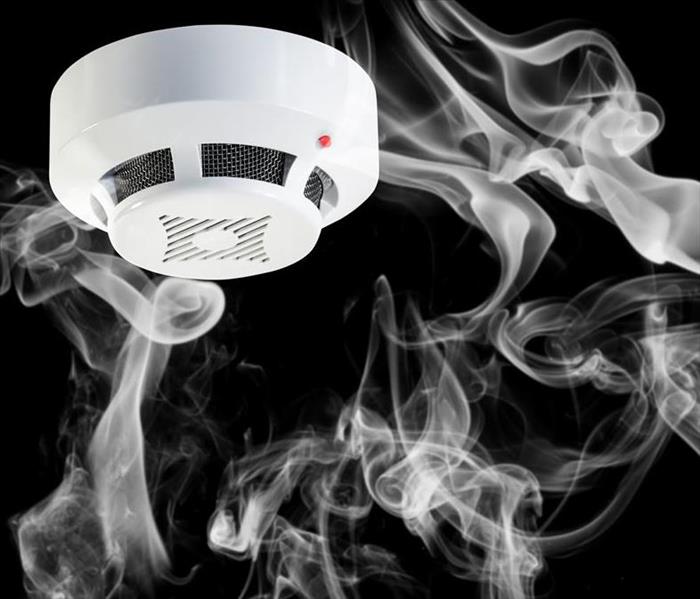 Learn More about Smoke Alarms and Prevent Fire Damage in your Clearfield, UT Home.
Learn More about Smoke Alarms and Prevent Fire Damage in your Clearfield, UT Home.
Many home fires become worse than necessary because their smoke alarm system malfunctioned. This happens because homeowners fail to replace the batteries in all the units or forget to perform regular maintenance on them. A smoke detector doesn't require much, but care is vital.
You should replace the batteries in each unit at least twice a year and then test them for functionality. Doing this can provide you with added peace of mind that your family and Clearfield, UT, home are protected against the worst.
Smoke Detector Maintenance Tips
In addition to replacing the batteries, there are several tips that fire damage restoration experts offer. Heeding these suggestions could mean the difference between minor to no damage and a total loss.
1. Ensure the Correct Placement of Each Unit
Smoke detectors must be installed in the correct locations to function correctly. One alarm must be installed in each bedroom. Additionally, at least one must be in the hallway (depending on the length of the space). Each of your home's floors (including the basement) must have at least one smoke alarm installed, ideally in every room.
The kitchen can be a little more complicated since there is a greater chance of false alarms when cooking. Units that are too close to the kitchen can also build grease residue, keeping them from functioning correctly.
2. Test Each Unit Regularly
Just as it's essential to replace the batteries often, it is also crucial to test each unit. Test the detectors every time you replace the batteries.
3. Clean Each Unit
Often Many people don't realize that you must clean a smoke alarm regularly. These units can gather dust, debris, and cobwebs like any other surface in your home. Cleaning is as simple as lightly wiping it down with a damp cloth or vacuuming it gently using your vacuum's hose.
4. Ensure You Have the Best System for Your Home
Several types of fire alarm systems are available, and they're becoming increasingly advanced to provide better protection. Interconnected units are either hardwired in your home or wireless and powered only by batteries. An interconnected system can prove to be very beneficial. The units communicate via radiofrequency. Therefore, if one is set off, they will all signal trouble. This means you will know there's a fire no matter where you are in the home. Some detectors even talk to tell you the fire area so that you can get to it quicker.
5. Replace Each Unit Routinely
Most fire alarms are manufactured to work for about 10 years. If you are unsure when your current ones were purchased, you can look for a date on the unit. Some devices have a sticker on the outside, and some have it on the label on the inside. If it is more than 10 years old or the date is unknown, it's best to replace it. After all, if it stops working correctly, it's as helpful as not having on at all.
Having a properly functioning smoke alarm system installed in your home is essential for avoiding potentially severe fire damage. Ensure your family's safety by following these five tips for maintaining your fire alarm system.
What Is Secondary Damage?
2/18/2022 (Permalink)
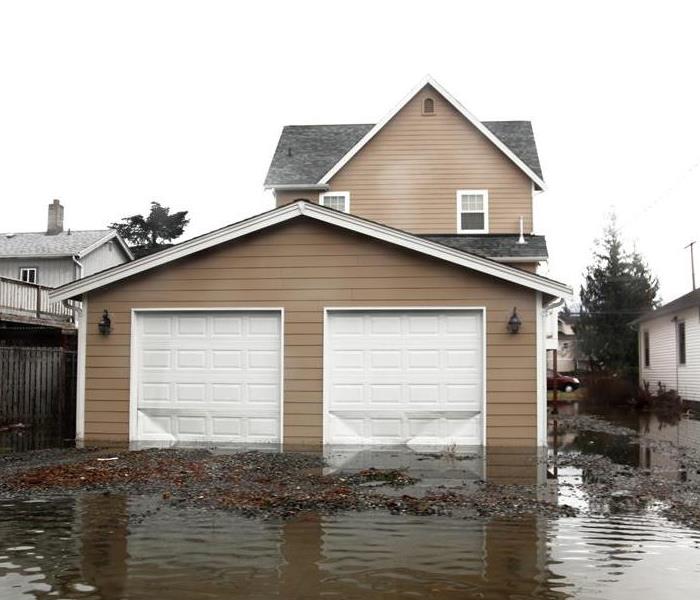 Learn more about Secondary Damage by following these tips.
Learn more about Secondary Damage by following these tips.
When you have water in your building due to a flood or leak, the water may directly damage your property. However, this is not the only risk that water poses. Water damage can also lead to secondary damage from black mold and other sources. Cleaning up water damage and fixing the source of the water problem is the key to preventing this additional damage.
What Are Some Common Types of Secondary Damage?
Water can cause problems not only due to the effects of the water itself but because of the high humidity caused by the water evaporating into the air in your building. There are several common problems typically caused by water damage:
1. Electrical Damage
Water that gets into the electrical sockets can severely damage the electrical system in your building. This may create a shock hazard. It may also increase the risk of an electrical fire. If there is a chance that water has gotten into your electrical system, shut off the power at the main breaker, or contact your utility company, and schedule an electrician in Clearfield, UT, to inspect and repair your system.
2. Wood Rot
Contact with water and humidity can cause structures made from wood to rot. Without repairs, this can create structural issues in your building.
3. Mold Growth
Black mold can begin to grow as soon as 24 hours after water damage occurs. This makes it important to resolve water issues as quickly as possible. If you are dealing with a flooded building, contact a water remediation company to remove the water and dry out your building. If you notice signs of mold, you may need to contact a mold remediation company to remove it.
4. Corrosion
Metal materials that have been exposed to water may rust. This can weaken the structure of the metal which can lead to additional damage, such as leaking pipes. Metal materials with signs of corrosion should be repaired or replaced.
5. Flooring Damage
Flooring materials, such as laminate or hardwood, may buckle when exposed to water. Buckled flooring must be removed and replaced. Promptly removing water from flooring materials may prevent buckling from happening. Drying the area under flooring is also important because water that is trapped under flooring materials can promote mold growth.
Other Causes of Secondary Damage
Many causes of property damage can also lead to additional indirect damage. For example, fire creates smoke and corrosive substances that can damage both your building and its contents. In some cases, the smoke damage is worse than the damage from the flames. Additionally, the water and chemicals used to put out fires can cause damage to your property.
Wind may cause indirect damage to your property by creating holes in your structure that allow rain or snow to penetrate your building leading to water damage. A lightning strike could indirectly damage your property by causing a power surge or a fire.
Black mold and other types of indirect damage can be serious problems. The best way to prevent this type of damage is to reduce the chance of the primary damage from occurring and remediate it promptly when it happens.
3 Ways To Prevent Extensive Roof Damage After a Storm
2/9/2022 (Permalink)
 Torrential hail can cause damage to your roof.
Torrential hail can cause damage to your roof.
High winds and powerful storms can impact your Clearfield, UT, home from its foundation to its rooftop. In fact, your home’s roof can be especially vulnerable to wind and hail storms, resulting in costly roof repair bills once they pass.
3 Things To Do To Prevent Further Damage To Your Roof
Here are some actions you can take directly after a storm that may prevent further damage to your roof until a contractor can arrive.
1. Inspect the Damage From the Ground
Once a storm passes and you suspect wind damage to your roof, the simplest way to detect any immediate problems is to go outside and look for them from the ground. Use a pair of binoculars to get a bird’s-eye view of areas that show missing shingles and note any damaged flashing as well. Take photos of visible problems so you can submit them to your insurance company and file a claim as soon as possible.
2. Cover Damaged Areas
Covering roof damage can help you protect the inside of your home, especially if the roof is leaking into the attic. Leaks can affect drywall and ruin insulation, so using waterproof tarp and ensuring the affected sections are secure can prevent these costly problems. This can be particularly helpful if your roofing contractor is busy after a storm and cannot get to your home right away.
3.Call for Restoration Help
If torrential hail and high winds caused water leaks into your attic, calling in the services of a storm cleanup and restoration company can be effective for reversing this damage. Storm cleanup technicians can inspect your attic, perform flood cuts to inspect interior walls and check for mold growth to ensure the space is properly cleaned and repaired.
Roof repair is often a common necessity after storms move through Clearfield, UT. However, knowing how to stem the worst of the damage until more in-depth repairs can be made may prevent leaks and other problems inside your home and keep your flood repair bill under control.
Flood Preparation Tips for Homeowners
1/20/2022 (Permalink)
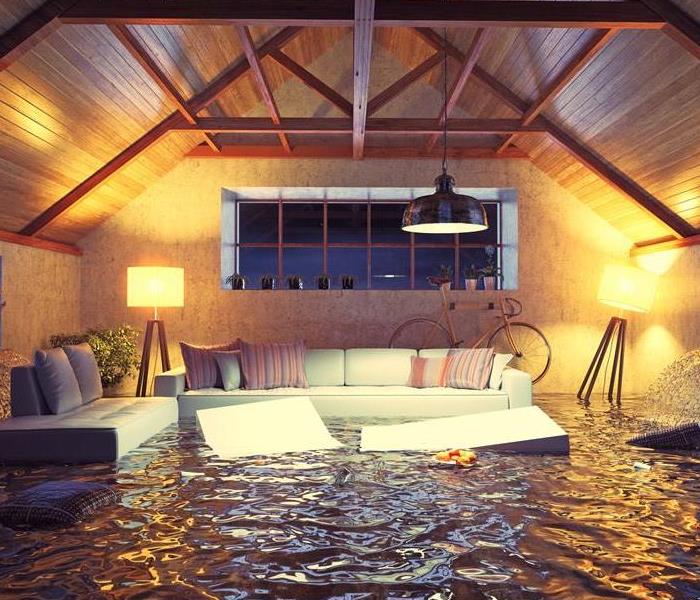 If you live in Clearfield, UT, bear in mind these tips in case of heavy storms and floods.
If you live in Clearfield, UT, bear in mind these tips in case of heavy storms and floods.
A heavy storm can lead to an invasion of flood water into your home. Before this happens, it's important to plan how you are going to handle it. The following tips not only can protect your house but also keep you and your family safe from risks associated with flooding.
Important tips to consider in case of heavy storms and floods
Gather Emergency Supplies
A natural disaster can result in loss of power or clean water. If this happens, you will need a few emergency supplies. While you can adjust your supply list to your family's specific needs, there are a few essential items that should be included in every emergency stash:
- Nonperishable food items in sealed, waterproof containers
- Bottled water
- First aid kit
- Essential medications
- Flashlights and batteries
- Personal protective equipment
Create a Flood Response Plan
Everyone in your family needs to know what to do if your home floods during a storm. Knowing when it's ok to stay and when you need to leave is crucial. Map out the best ways to get out of your home if the door is obstructed, and make sure everyone knows what is expected of them. It's easier to respond quickly to evacuation mandates if you already have a well-practiced plan in place.
Keep Drainage System Clear
Nothing leads to a flooded building faster than a deluge with no other place to go. Clean out your gutters and downspouts regularly to keep them clear of dirt, twigs and other debris. Make sure your drainage system directs flood water away from the foundation of your home rather than toward it.
Protect Important Belongings
You don't have to wait until the storm hits to protect your valuables. It's a good idea to always store important or delicate items on higher shelves or in the upper level of your home, especially important during storm season. Keep original copies of vital documents such as birth certificates, the deeds to your home and cars and other essential papers in water resistant containers. Digitize as many of your records as possible so that you don't lose the information if water restoration specialists can't salvage the paper copies.
Purchase Flood Prevention Equipment
You may not be able to completely avoid storm damage, but with the right equipment you can minimize it. A sump pump in your basement is a great line of defense against flooding. Even items as simple as sandbags can create a barrier between your home and rushing water.
Be Aware of Your Home's Flood Risk
Your flood plan is only as good as your risk awareness. If your home in Clearfield, UT is in a flood plain, you definitely need a separate flood policy as part of your insurance coverage. Even if the area where you live is not prone to flooding, a lawn that slopes toward your house rather than away from it or a lack of barriers between runoff and your foundation can cause significant problems during a storm. Knowing your risk level can help you take the necessary precautions to avoid or minimize water damage to your home.
There is a lot you can do to protect your home from damage due to flood water. Good preparation can help you weather even the strongest storm.
6 Tips for Dealing With a Water Damaged Wood Floor
1/14/2022 (Permalink)
 Bear in mind these 6 tips for dealing with a water damaged Wood Floor in Clearfield, UT.
Bear in mind these 6 tips for dealing with a water damaged Wood Floor in Clearfield, UT.
Getting any kind of flooring wet is not ideal, but water damage from a pipe burst or other source can be particularly damaging to wood floors due to the porous nature of the material. These tips can help you minimize the damage to your wood flooring.
How To Save Your Wood Floor From Water Damage
Drying your wet floor quickly is the most important thing you can do to reduce the amount of damage. These are some steps you can take:
1. Remove Wet Objects From the Floor
Wet objects, such as rugs and furniture, can continue to leech moisture into the floor. They may also develop mold and mildew that can infiltrate the seams and pores of your flooring. Remove all wet items and place them in an area, such as outside, where they can dry without damaging the floor.
2. Clean Up As Much Water as Possible
If you are dealing with a small spill, you can absorb the water with mops, towels and clean rags. For larger spills, such as a pipe burst, use a wet vacuum and run it until you no longer see any new water being pulled into the canister. If you don't have a wet vacuum, you may be able to rent one in Clearfield, UT.
3. Clean the Surface of the Wood
Debris and dirt in the pores of the floor can retain water and bacteria that may damage your floors. Clean the floor with a disinfecting cleaner that does not make suds. Use a soft-bristled scrub brush. After you have cleaned the floor, run the wet vacuum another time to remove any water and then use a wood floor cleaner to remove any leftover disinfectant. Rinse the floor and dry it one more time.
4. Thoroughly Dry the Wood
Even if your floor appears to be completely dry, there may be water that has penetrated the plank that can not be removed with a wet vacuum. Put a dehumidifier in the middle of the room and run it for at least 24 hours to help dry the floor. Position fans around the room to blow air across the surface of the floor. If the damaged floor is on an upper level, place fans on the level below and aim them at the ceiling to help dry out the subfloor. If the weather is dry, you can open doors and windows to increase air circulation.
5. Check for Mold
Mold can begin to develop 24 to 48 hours after water damage. Inspect the floor for signs of mold growth. If you believe you have a mold problem, consider contacting a mold remediation company to address the mold issue before it gets worse.
6. Test for Moisture
Use a moisture testing meter to check for any moisture remaining in the wood. It may take several weeks for your floor to completely dry out. Continue to run your dehumidifier and fans until no moisture remains.
The longer you wait to dry out your flooring after a pipe burst or other water damage occurs, the more damage your floor is likely to sustain. Taking quick action can prevent unnecessary damage.
How To Restore Your Business After a Fire
1/11/2022 (Permalink)
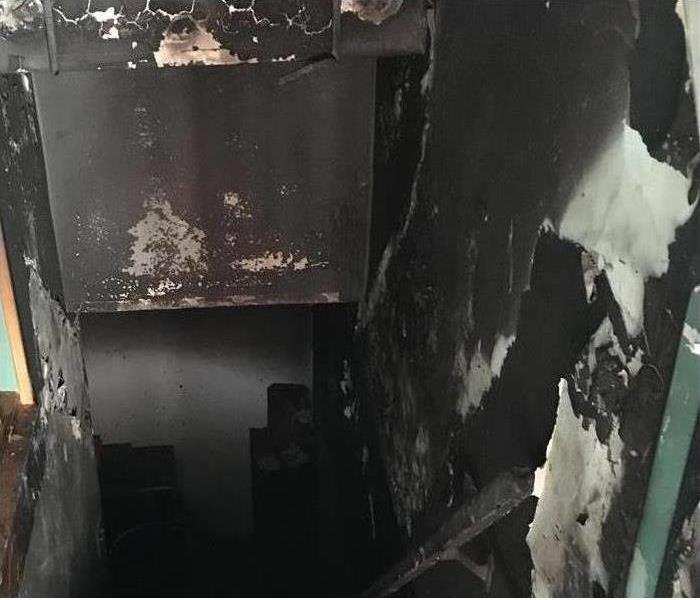 Fire Damage in Clearfield, UT.
Fire Damage in Clearfield, UT.
Coping with the aftermath of a fire on your commercial property may feel overwhelming at first. Not only do you have to deal with the destruction caused by the fire itself, but there might also be smoke damage, water damage, and troublesome soot left behind. Fortunately, things are not always as bad as they seem, and restoration is often possible. Here are a few steps to getting your business up and running again after a fire.
3 Steps to Restore Your Business After a Fire.
1. Evaluate the Damage
The first step is to develop a plan of action for the repairs. Calling a commercial fire restoration expert is the best way to ensure that any fire damage, smoke damage, or water damage is properly attended to. Trained professionals know what to look for and how to handle many common issues that occur after a fire. In addition to crafting a cleanup plan, they will take measures to prevent future damage. This includes boarding up destroyed windows and doors, as well as covering up holes in the siding or roof.
2. Water Removal
Oftentimes fire hoses leave excess water in the building. Water removal should be done promptly in order to prevent mold growth or more severe structural degradation. Restoration specialists begin by eliminating any standing water. Next, they use a combination of fans, dehumidifiers, and air movers to fully dry out the space.
3. Clearing Smoke and Soot
Dealing with soot damage and lingering smoke is one of the most important parts of fire cleanup. Soot and smoke may penetrate into linens, carpets, furniture, and other products. They can even damage paint or drywall. Open windows to ventilate the area as well as possible, and use gloves to remove any burned debris. Smoke cleaning and soot removal are best completed with professional help. A restoration company will utilize specialized techniques and tools to remove odor and residue.
Whether you need assistance with smoke damage, water removal, or cleaning and restoration, certified fire damage specialists in Clearfield, UT, are never more than a phone call away. Time is of the essence when restoring your business after a fire, so choose the pros who are Faster to Any Size Disaster.
Fire Alarm Essentials: How Many and Where To Put Them
1/6/2022 (Permalink)
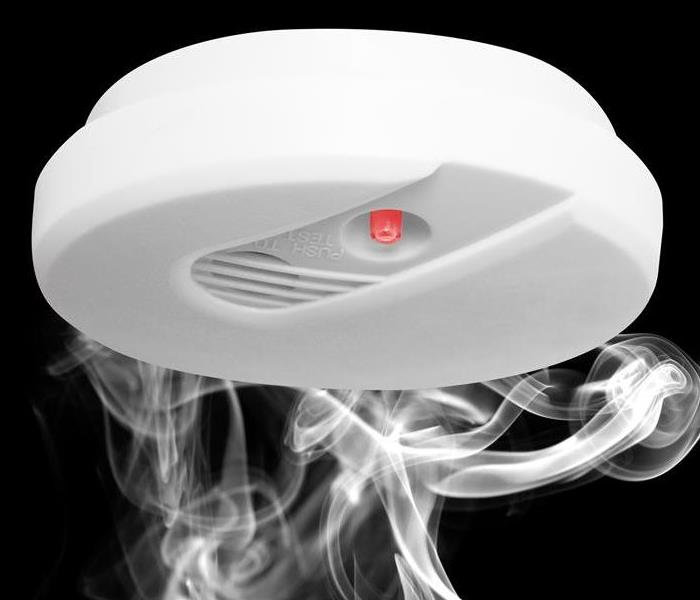 Prevent residential fire in your Clearfield, UT home by following these important tips.
Prevent residential fire in your Clearfield, UT home by following these important tips.
A house fire is among the top fears of existing homeowners. The thoughts of devastation, damage, injury, and loss are enough to set shivers down the spine of even the most prepared owner, even those who have a fire alarm in every recommended space.
These important tips will help you to prevent Residential Fire
Smoke and fire detectors are essential protective devices for the home. Unfortunately, many people either do not see the significance of the products or have fewer alarms than they should.
Talk to a restoration service in Clearfield, UT, to learn more about the number of detectors needed for your home and about proper placement. The general areas of concern include:
- Bedrooms
- Kitchens
- Laundry rooms
- Basements
- Attics
The Fire Alarm: Quantity and Placement
Fires move at various speeds, dependent on what is feeding the fire. Fire and smoke detectors can provide homeowners with valuable insight into the movements of the fire, allowing for a quicker and safer escape. Additionally, the sooner a family receives an alert, the sooner they can call for help or use fire extinguishers to eliminate the threat, resulting in less structural and smoke damage.
However, without the adequate number and placement of alarms, your house and family are at risk of damage and injury.
Understanding how the size of your home and the number of rooms affects your decisions will help ensure your family stays safe in an emergency.
How Many Fire Alarms Do You Need?
While the primary reason for alarms is not to prevent fire damage, it can be a natural side effect of having an adequate number of devices in your home. Because families are alerted to danger quickly, fire response is sped up as well, resulting in less damage. However, for a rapid response, you need to ensure enough fire alarms in your home. How many will depend on the size of your home and the number of bedrooms and levels.
You typically want one alarm in each bedroom and one on every floor. You might also want an alarm in high-risk areas like kitchens and laundry rooms. The bare minimum recommendation is one detector per 500 square feet, with no more than 30 feet between each.
Where Should You Install Fire Alarms?
Fire alarms need to be in high traffic and low traffic areas of the home. For instance, while you might not use your basement or attic that often, fires can start in each location, leading to significant damage.
Additionally, you need the alarms to be where you can hear them. Interconnected alarms are often suggested because they alert a family to a fire's location wherever they are in the home. The best placement for alarms is anywhere fire is possible, and anywhere someone can hear it. Therefore, bedrooms, kitchens, laundry areas, basements, garages, attics, etc.
A fire alarm is a necessary safety device, and every family should have the appropriate number of alarms for their house. If you are not sure how many alarms are needed for your home or the best placement for those alarms, contact your local fire department of a fire mitigation service for help.
The 4 Stages of Keeping Your Business Running After a Flood
12/19/2021 (Permalink)
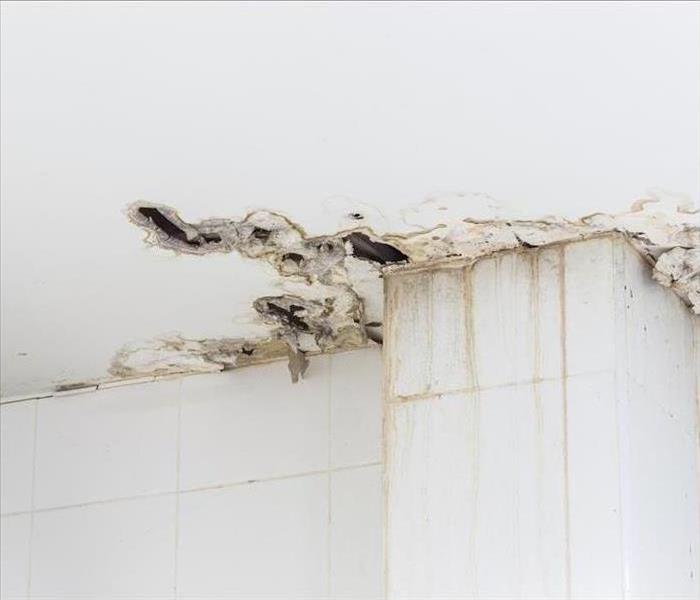 The ceiling of a building damaged with water after heavy rains.
The ceiling of a building damaged with water after heavy rains.
After a storm hits Clearfield, UT, your business may be flooded. Repairs with even the most efficient water damage specialists can take some time, and your business needs to keep running while they are in progress. Having a business continuity plan is essential to keeping your business going and your income flowing. Here are the four stages of constructing a plan that will help you weather storm damage to your building.
4 Stages of a Plan to Keep Your Business Running After Storm Damage
- Analysis
The first thing you must do is identify essential services and what you need to make them happen. Develop and distribute business impact analysis questionnaires to all personnel. Then conduct follow-up interviews to make sure your information is correct and that nothing is missing.
- Strategies
It is likely that your BIA will reveal discrepancies between what you would need in a flooding situation and what you are currently capable of doing should your business flood tomorrow. A recovery strategy team should be formed to come up with and implement strategies to eliminate those discrepancies.
- Plan
The third stage is formulating your business continuity plan. Divide the labor among recovery teams. Make decisions regarding relocation. Confirm that you have an information and document recovery system in place so that essential resources are protected. With management approval, write down the details of the plan.
- Practice
A plan is only as good as its execution, so it's important to test your plan. Train everyone involved, and give it a practice run. Take careful notes to document what works and what doesn't so that you can fix problems before you have to put the plan into action for real.
Once you have gathered information, omitted shortcomings, drafted a business continuity plan, and tested the plan, you can rest assured that stormy weather is unlikely to be your company's undoing. By being prepared for potential problems, you protect yourself and your employees.
How To Handle a Leaky Faucet
11/24/2021 (Permalink)
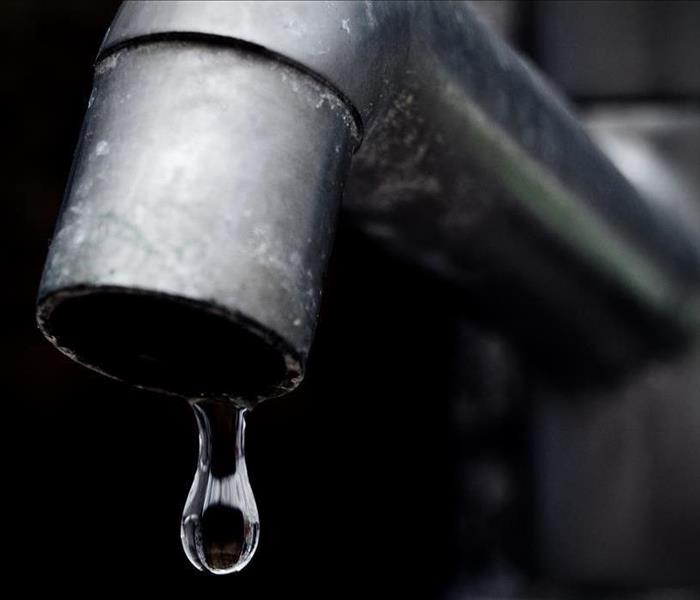 Repair your leaky faucet as soon as possible to avoid water damage in your Clearfield, UT home.
Repair your leaky faucet as soon as possible to avoid water damage in your Clearfield, UT home.
A leaky faucet may seem like a minor annoyance, but it can cause a spike in the utility bill as well as significant water damage if it is allowed to persist. Knowing how to fix a leaking faucet, therefore, is a useful skill for homeowners in Clearfield, UT. Here are some simple steps to follow to ensure that you do the job correctly.
3 Steps to Handle a Leaky Faucet
1. Repair Water Damage
A dripping faucet is likely a sign of a mechanical problem, and that means the water may not just be dripping into the sink and flowing safely down the drain. Faucet repair should start with assessing the damage to the surrounding cabinet. If there is a problem, call local water restoration professionals such as SERVPRO. SERVPRO is a preferred vendor for many insurance companies for several reasons:
- 24-hour emergency response
- Certified technicians
- Service warranties
- Easy-to-access Claims Information Center
To fix the issue, technicians must turn the water off to the faucet. Then they tear out damaged materials and rebuild the cabinet. Once the damage is repaired, it's time to fix the faucet to prevent future problems.
2. Identify the Problem
There are many issues that can cause a leaking faucet. In a compression faucet, the seat washer may need to be replaced. A ball faucet includes various components such as O-rings, cam washers, valve seats, and springs, that could be faulty. If you have a cartridge faucet, the O-ring is the likely culprit. Once you have identified the part that is causing the problem, you simply replace it and reassemble the faucet in the reverse of the order you used to take it apart.
Sometimes, all that you need to do is tighten a part of the faucet's mechanism. Most homeowners already have the tools to do this at home. If you need a part or a tool, you can typically find it at the local hardware store.
3. Know When To Ask for Help
If you can't find the problem or the steps you take don't fix it, it is time to call the plumber. Finding a certified professional to take care of the issue does more than just restore the use of the faucet in a timely manner. It also helps you avoid further water damage that occurs due to an unresolved issue.
Filing an insurance claim for water damage can be tricky. It's even more difficult when the problem is exacerbated by poor repair decisions. If you can achieve a fixed leak, that's great. However, if your efforts don't yield the necessary results, you could set yourself up for a large out-of-pocket expense if your mistakes lead to further damage. Knowing when to admit you need help can save you a lot of time and money.
Fixing a leaking faucet is usually easier than it seems. Once you learn how all the parts fit together, reassembling the fixture with new parts is no problem. The bigger issue is often the water damage resulting from the leak. A quick call to SERVPRO, however, gets the affected area repaired and restored in no time.
Will Filing an Insurance Claim Raise My Rates?
11/16/2021 (Permalink)
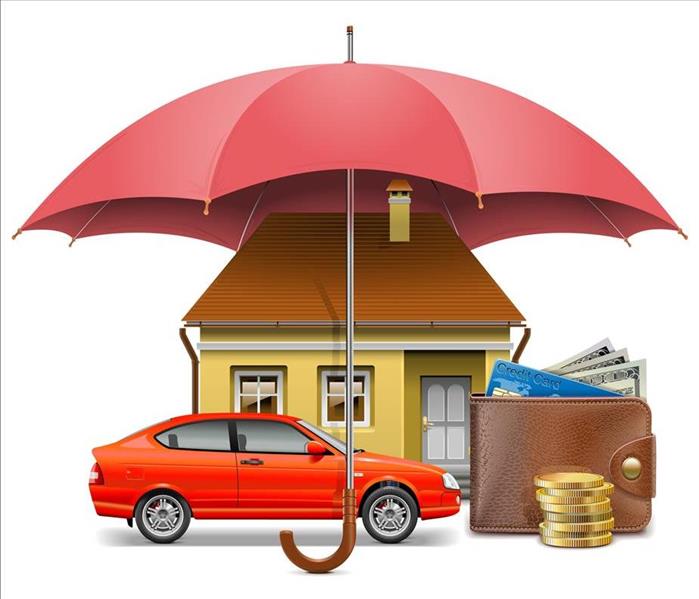 File an insurance claim only when it is essential to avoid increased rates.
File an insurance claim only when it is essential to avoid increased rates.
Homeowners' insurance exists to provide financial protection for homeowners against catastrophic damage to their homes. However, many homeowners fear that filing an insurance claim may cause their rates to go up. This isn't always the case.
How an Insurance Claim Affects Your Rates
Insurance premiums are primarily based on risk. For homeowners insurance, insurance companies consider both the risks associated with the policyholder and the property being insured. Several factors can affect insurance rates:
- Value of your home
- Your credit history
- Age of your home
- Location of your home
- Materials your home is constructed from
- Your claims history
- Your marital status
Homes that are worth more money and cost more to replace usually cost more to insure. Insurance companies also consider location-based risk factors, such as weather conditions and proximity to water sources. Homes that are made out of materials that better withstand fires, wind and other perils may cost less to insure. Finally, the fewer claims you have filed and the less those claims cost your insurance company, the less you are likely to pay.
Why Claims History Matters
Past behavior often predicts future behavior. Policyholders who have filed claims in the past are more likely to file claims in the future. However, the type of claim, how long ago the claim was filed and the cause of the damage also has an impact on whether filing a new claim will increase your rates.
Claims That Are Likely To Increase Your Rates
Insurance companies consider some types of claims to be a greater indicator of a high risk of additional claims than others. Dog bites, water damage, personal injury claims, and mold claims fall into this category.
Claims That Are Less Likely To Cause a Rate Increase
Small homeowners' claims, such as minor water damage caused by a pipe burst, may not result in rate increases unless you make a lot of them. If the insurance company determines that you are filing a lot of small claims because you are not properly maintaining your home, they may increase your rates or refuse to renew your policy.
Typical Rate Increases
A typical claim may result in a rate increase of 20% to 40%. Your rates may remain higher for several years and then go back down if you do not file additional claims. Some insurance companies may not raise rates for a first claim or claims under a certain dollar amount.
When To File a Claim
If you have a home flood or other major disaster, you may have no other choice than to file a claim. It probably does not make financial sense to pay for large amounts of damage out of pocket when you have insurance. For smaller claims, such as the cost to hire a remediation company in Clearfield, UT, to clean up a minor mold problem, you should weigh the cost of paying for the damage out of pocket versus the potential increase in your insurance rates.
Purchasing insurance won't do you much good if you are afraid to ever file an insurance claim. However, making wise decisions about which claims to file can help keep premiums low.
Dealing With Toilet Overflow
11/12/2021 (Permalink)
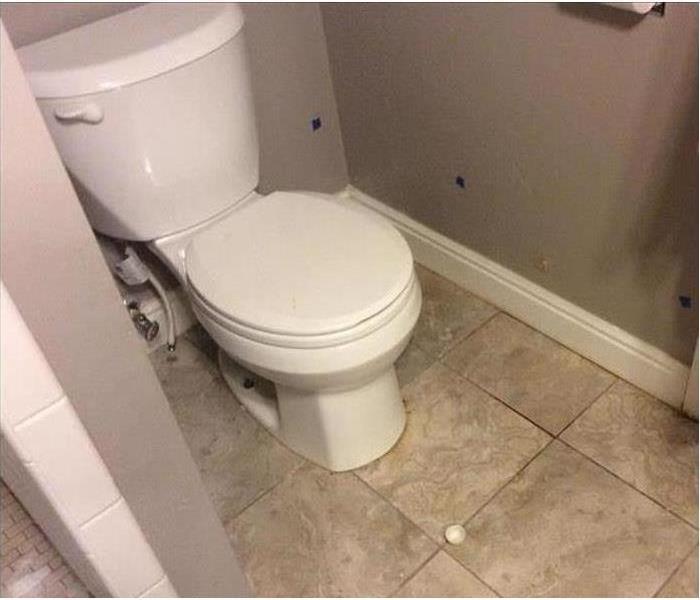 Avoid toilet floods in your Clearfield, UT home.
Avoid toilet floods in your Clearfield, UT home.
When a toilet floods your home in Clearfield, UT, it is unlikely that you are dealing with clean water that can just be sopped up with a towel. To properly mitigate sewer damage, you will need to take certain precautions and enlist the help of certified sewer cleanup experts.
5 Steps for Dealing With Toilet Overflow
- Protection
Safety is the first thing you should consider. Because the water from a flooded toilet is a Category 3 contaminant, it is imperative that you keep pets and children away from the area. Do not enter it yourself unless you are wearing protective gear, such as coveralls, goggles, a face mask, and rubber boots.
- Air Flow
Fresh air can displace the microbes that are in the affected area’s airspace. If possible, open a window to increase ventilation. Avoid using your HVAC system to do so, however, as this simply allows the airborne germs resulting from sewer damage to spread to other parts of your home.
- Sewage Removal
The team from the sewage company will remove the water from the area. All items such as rugs or linens that the water touched must be removed as well.
- Drying
After the standing water is removed, all surfaces must be dried. If the contaminated water has seeped into the floors or wall, it will likely need to be replaced with dry, undamaged materials.
- Disinfection
The final step is making sure everything is clean. Mitigation professionals use special detergents and other methods to clean the remaining surfaces in the room as well as any items that can be salvaged. No item can return to your home unless it can be restored properly.
Sewer damage requires swift attention and remediation. Start with the appropriate safety measures and make sure all the appropriate steps of the cleanup process are taken. With a prompt call to certified experts, you can get your bathroom restored relatively quickly.
Avoid Lawsuits and Negative Mold Insurance Claims
11/8/2021 (Permalink)
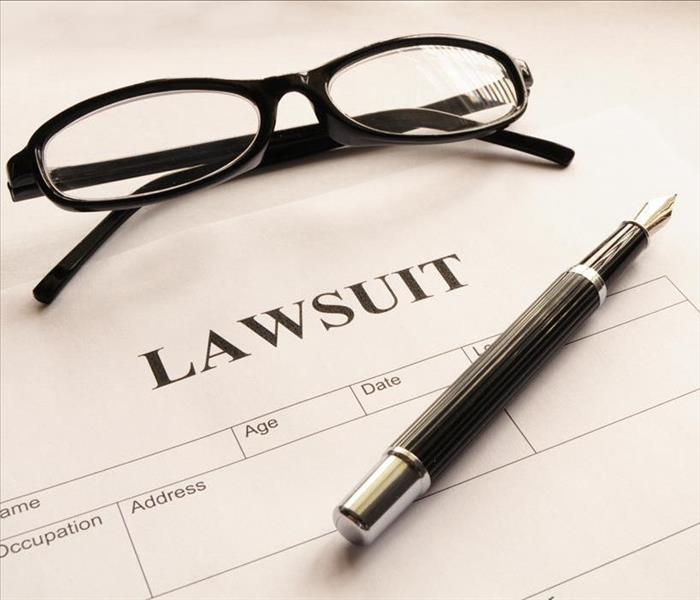 Be sure to make proper maintenance in your Clearfield, UT property to avoid lawsuits from tenants.
Be sure to make proper maintenance in your Clearfield, UT property to avoid lawsuits from tenants.
Property owners are responsible for providing a safe environment that is free from unreasonable risks. For example, if a client or tenant trips and is injured because of the related fall, the property owner may be held liable for the costs associated with the accident. Unfortunately, there are many types of conditions that could be considered dangerous:
- Uneven steps
- Slippery floors
- Falling items
- Lack of lighting
- Limited security
- Defective appliances
As the owner or manager of a commercial property, you could find yourself liable for any injuries that occur because of these conditions, as well as others. A lot of property maintenance issues are easy to spot and recognize, but some are less obvious, such as mold growth. The consequences of missing signs of mold often include mold insurance claims and lawsuits from tenants.
Potential Mold Insurance Claims and Lawsuits
The rules governing when and how a lawsuit can be filed vary from state to state, but most states maintain an implied warranty of habitability, meaning that property owners and managers are required to maintain the building and make sure it is safe, livable, and workable. If you fail to provide adequate care and maintenance for the property and mold causes damage, tenants can sue.
Non-Disclosure
If you knew that mold or related damage was present and you didn't warn disclose this to the tenant, you may face a lawsuit. It is illegal for you to keep this information quiet. If serious damage or injury occurs as a result of the mold, you could face hefty financial penalties.
Uninhabitable Situation
Once the presence of mold is obvious, professional mold remediation must take place quickly. Otherwise, the tenant can legally withhold rent or move out of the property (with or without a contract). Remember that the cost of remediation is usually easier on your budget than the costs associated with lawsuits. Reach out to your insurance provider to learn more about your mold insurance claims.
Lack of Reimbursement for Repairs
Tenants may arrange for cleanup and repairs on their own, and you may be required to reimburse them for those repairs. This is especially true if you neglected to arrange for repairs within a reasonable amount of time. If your tenant has to sue for reimbursement, you'll end up paying more than you would have for the original amount of the mold claim.
Injuries
Mold growth can cause a lot of property damage, including weakening the structural integrity of walls, floors, and ceilings. If that damage leads to a situation where a tenant or someone visiting the property is injured, you may be subjected to a lawsuit.
Proof of Neglect
Don't dismiss your tenants' concerns about the presence of mold. If tenants reach out to professionals for environmental testing or a damage assessment and you do nothing about the findings, there's a good chance that you'll face a mold growth lawsuit.
It is possible to make mistakes in your efforts to be a responsible property owner in Clearfield, UT, but what you don't know can still land you in legal trouble. Avoid the legal and financial penalties of failing to work through cleanup, remediation, and mold insurance claims by arranging prompt professional action.
Understanding the Necessity of a Flood Cut After Flooding
10/26/2021 (Permalink)
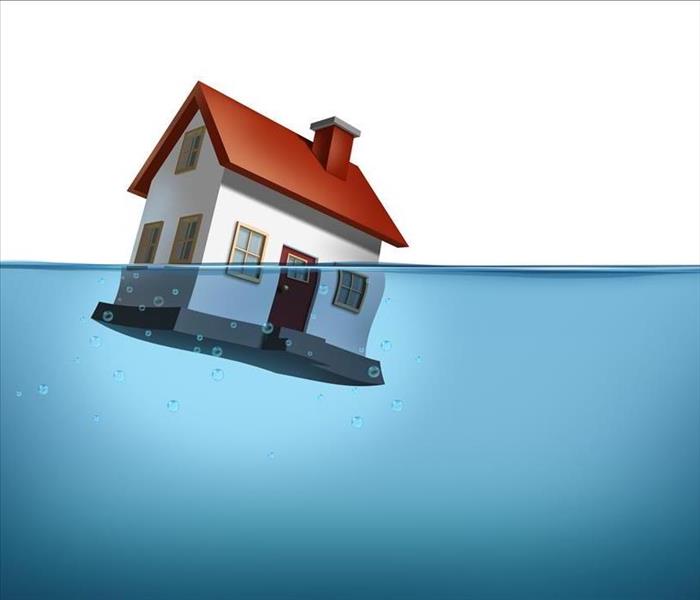 Flood cut after a flood in your Clearfield, UT home, it is indispensable to avoid contaminated water.
Flood cut after a flood in your Clearfield, UT home, it is indispensable to avoid contaminated water.
A flood cut is a necessary tool for remediation experts in Clearfield, UT. After flooding recedes, the remediation crew will make a cut at least 12 inches above the flood line. While it is called a cut, it involves the removal of drywall, insulation, and any other materials below the designated line. There are many reasons companies use flood cuts.
4 Reasons Remediation Companies Make a Flood Cut After Flooding
A flood cut is meant to help eliminate further risks of contamination. Many homeowners struggle to understand the objective of a cut because all they see is materials being removed from their homes.
While it can be challenging to watch as crews remove drywall, insulation, and other items from your home, know that there are several reasons for the apparent madness. In fact, there are at least four reasons for making a flood cut.
1. To Reduce the Risk of Mold
Remediation companies will tear out materials above a flood line to reduce the risks of mold. While a flood line shows where the water level rose, it does not show how much of that water was soaked into the insulation.
Remediation experts assert that 12 inches above is the minimum necessary cut to reach dry materials. Therefore, by removing above the flood line, you take away potential moisture sources for mold spores.
Mold can develop within one to two days after flooding. By making a flood cut, remediation crews cut down the risks of development.
2. To Dry the Area Thoroughly
A flood cut is also used to help dry an area after a flood. There is no other way to access a wall cavity than by removing sections of drywall and insulation. With the cavity exposed, remediation crews can use fans, air movers, and dehumidifiers to help dry the space thoroughly and quickly.
The speed a space is dried can also reduce the risks of other problems, like mold and structural issues. The longer water is allowed to stand, the more damage it can do to the integrity of your home.
3. To Inspect for Structural Damage
While flood cuts are necessary for avoiding extensive damages, they can also be used for inspecting the structure after a flood. By opening the walls, a restoration company can tell how much damage actually occurred. Water damage can lead to wood rot and foundational issues, making structural assessments crucial after a flood.
4. To Make Any Necessary Repairs
Floods can lead to electrical and plumbing issues. In many instances, the only way to get to the affected systems is by opening up the walls. Remediation experts will do their best to limit the amount they open walls, but again, 12 inches above the flood line is standard practice.
While flooding is a nightmare for most homeowners, it is not impossible to recover from the damage. With the right crews performing tried and tested techniques, you can have your home restored in no time. However, remember that the amount of work needed will depend on the length of time the floodwaters remained and how deep they were.
Items To Throw Away After a Fire
10/18/2021 (Permalink)
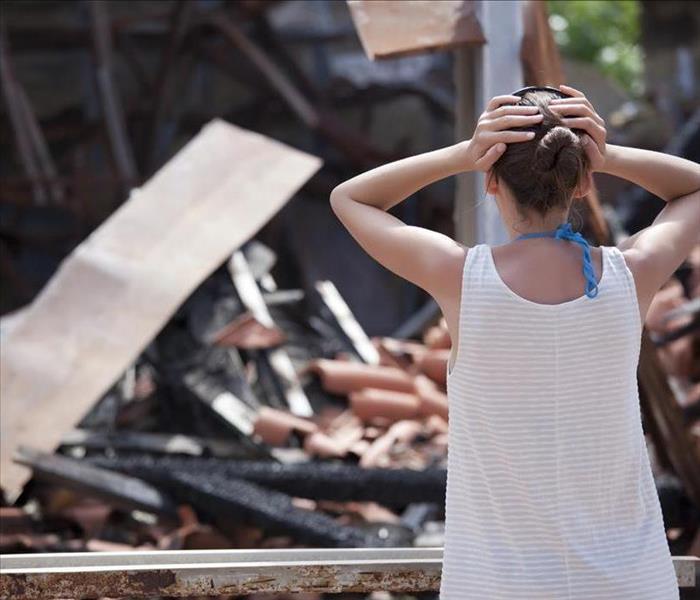 Some items, after a fire in your Clearfield, UT home, should be thrown away.
Some items, after a fire in your Clearfield, UT home, should be thrown away.
When your home in Clearfield, UT, catches fire, you may have to replace a lot of things. Important documents may be destroyed, and it may be less expensive to replace certain textiles rather than pay to have them cleaned. Fire restoration experts can help you determine which items are salvageable. There are some items, however, that you must always throw away after they are exposed to a house fire.
Items To Throw Away
Food Damaged by High Heat
It makes sense that perishable food that clearly smells like smoke or is packaged in a porous container such as cardboard would need to be thrown away after a fire. Even items that look ok on the surface may need to be tossed in the trash, too, though. If your pantry and refrigerator were exposed to high heat, you need to throw out everything in them:
- Canned foods
- Dry goods
- Spices
- Oils
- Condiments
While it is certainly disheartening to have to get rid of so much food, it is better to waste it by throwing it in the trash than to eat it and make yourself sick. Food that is exposed to the conditions of a house fire often starts to grow bacteria and spoil, even if its packaging still looks intact. To be on the safe side, toss it out and rebuild your pantry stash.
Medicine Exposed to Flames
The chemical composition of medication is uniquely formulated to produce specific health benefits. A fire changes all of that. If your medication was close enough to the fire for the packaging to melt, you definitely need to get rid of it. It is no longer safe to take.
In fact, unless the fire in your home was in a very small, contained area, you can't guarantee that the room where your medication is stored remained cool enough to keep it safe. It's best to throw away all pills and other drugs in the house, even if they don't show signs of burning or smoke damage.
Cosmetics Stored Near Affected Area
The same rules apply to your cosmetics and toiletries. Regardless of what the expiration date on the container says, if they were exposed to the heat of the fire in any way, you should consider them collateral fire damage and toss them out.
If the fire was near the bathroom or vanity where your cosmetics are stored, they have probably been ruined. Take pictures and make a list of all the items as you pitch them into the trash so that you know what you need to replace. This may be helpful information when you are filing your insurance claim. Depending on your policy, you may be compensated for the cost to replace them.
A house fire can be devastating in many ways. Some of your belongings may be able to be saved, but that doesn't apply to everything. Perishable items such as food, medicine, and cosmetics are sensitive to the heat produced in a house fire. You must throw away anything that could have been chemically altered by the presence of fire and replace it with something new.
How To Perform Pipe Burst Cleanup
10/6/2021 (Permalink)
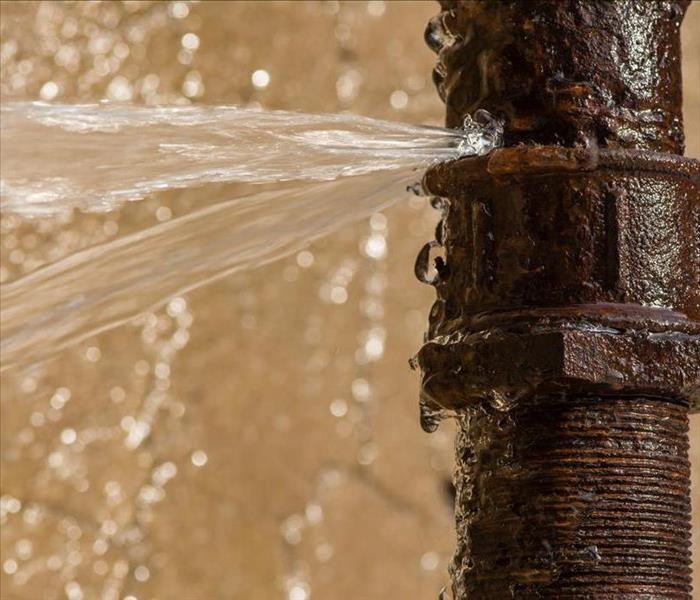 When a pipe bursts, clean the water to avoid further damage in your Clearfield, UT building.
When a pipe bursts, clean the water to avoid further damage in your Clearfield, UT building.
Freezing weather or aging or damaged pipes can cause a pipe to burst, creating a messy situation that requires pipe burst cleanup to avoid additional damage. This guide will walk you through some steps you can take when you are dealing with a burst pipe.
7 Step Water Cleanup Process
Whatever the cause of your burst pipe, it is important to perform water cleanup within 24 to 48 hours. After that point, even clean water can become hazardous to come in contact with and mold growth may because an issue. These seven steps can help you get your property cleaned up and dried out.
1. Shut Off the Water
Whether you have a broken pipe or a supply line leaking, the first step is to mitigate the damage by turning off the water supply. Make note of the location of the main water shut-off valve at your facility so that you can access it quickly when a problem occurs.
2. Remove Wet Contents
The longer anything that is wet stays in your building, the more likely you are to have problems with mold. Move wet furniture and other contents out of the building. Items that can be salvaged can be left in the sun to dry out. Other items, such as wet carpet or drywall, should be thrown out.
3. Remove Standing Water
A submersible pump is the most effective tool to use for removing water. If you don't have one, you may be able to rent one. Alternatively, you can contact a water remediation company in Clearfield, UT, to handle the job for you. For smaller amounts of water, you may be able to remove it using a wet-dry vacuum, a bucket, or a mop.
4. Dry Out Your Property
Once the water is gone, the next most important part of pipe burst cleanup is to dry out your property. Fans and dehumidifiers are useful tools for this process. If the weather permits it, open windows and doors to get some air circulating.
5. Tear Out Damaged Materials
Some materials are difficult to salvage once they get wet. You may need to remove and replace carpeting, carpet pads, flooring, drywall, cabinets, hardwoods, and ceilings.
6. Fix the Broken Pipe
Before you can turn the water back on, you need to cut out the section of the broken pipe and replace it. You can tackle this job at any point in the restoration process, but it is usually easier after you have removed damaged materials, but before you have started replacing them.
7. Clean and Disinfect Surfaces
Water from a burst pipe is usually clean water, but it is still a good idea to clean and disinfect surfaces that were in contact with the water. Use a mild detergent to clean surfaces and then apply a disinfectant, such as diluted bleach. Opening windows can help remove odors. If odors linger, you may want to use an ozone machine.
Once you have completed the pipe burst cleanup process, you can begin repairing your damaged property. Regularly inspecting your plumbing may help you avoid a recurrence of the problem.
How SERVPRO's Insurance Claims Inventory System Helps Reduce the Stress of Managing Your Claim
9/27/2021 (Permalink)
 Insurance claims inventory system facilitates the process of managing your claim.
Insurance claims inventory system facilitates the process of managing your claim.
An insurance claim is sometimes a tricky undertaking for your average homeowner. Most people have little experience with the process, meaning they are out of their depths when speaking with an insurance agent. Thankfully, SERVPRO is a company familiar with the disaster and remediation game. The company's teams understand the vulnerability on the homeowner side and the research needs of the insurance side, which is why it created the claims inventory system — a system designed to make the entire claims process more transparent and approachable; it does this in several ways:
- Access to estimates
- Access to timetables
- Access to reports and communications
The Importance of Transparency
When a homeowner begins the claims process, they can feel overwhelmed and left out of the discussions surrounding their property. SERVPRO's stance is that the customer deserves to know what is happening with their claim and project every step of the way.
Through the company's innovative system, clients can see everything related to their project. Additionally, the company works as a sort of intermediary between the insurance company and the client, explaining everything in detail and in terms the client can understand.
Transparency breeds trust, and it is crucial when entering someone's personal space — their home. A homeowner can feel more confident in the restoration process when they are made equal partners in the discussion.
The Importance of Comparable Estimates
Homeowners are not the only ones who require transparency. The insurance adjuster assigned to your claim will also need access to files and paperwork to make a decision regarding your claim. SERVPRO's system provides access to research and comparable job reports to help the adjuster develop an accurate assessment of the damage done to the homeowner's property.
Being able to search a system and find reports for various jobs and across various states, allows the insurance agent to make accurate and fair calculations about a claim receipt. Ultimately, the system helps insurance establish estimates for coverage while ensuring homeowners receive a fair analysis through current reports.
What You Can Do To Make Insurance Claims Easier
If you want to make an insurance claim easier, it comes down to preparation. After any disaster, you will need to create a loss inventory — a list of all property damaged or destroyed in the disaster. It is best to find receipts for all damaged and lost goods and to take pictures of all the damage. You can present all of this information to the adjuster when they arrive.
The disaster restoration service can help you compile all necessary information. The teams working for these companies understand what is involved in the claims process and will have no problem walking you through it.
How SERVPRO's Claims Inventory System Helps
The primary benefit of the claims inventory system is that it places all pertinent information in one place. There is no need to dig around filing cabinets or do exorbitant amounts of off-site research.
The insurance claim process can be overwhelming if you are not used to it. Thankfully, SERVPRO's system and technicians in Clearfield, UT, can help make the entire process easier.
Tips for Handling Water Damage
9/14/2021 (Permalink)
 Knowing how to handle a leak will minimize the water damage in your Clearfield, UT home.
Knowing how to handle a leak will minimize the water damage in your Clearfield, UT home.
A broken pipe can cause a huge water loss in a short amount of time. What you do right after it happens can determine how much damage it ends up causing.
How to minimize leak damage
Don't Ignore Signs of Water Damage
One of the problems with a pipe break or any water loss that happens behind a wall or inside a cabinet is that you may not discover it until damage has already been done. Watch for common signs that you have a leak:
- Dark spots on walls or ceilings
- Bulging drywall
- Swollen floorboards
- Excessive humidity levels
- Unusual spraying or dripping sounds
Do Turn off Water
If you see a spot on the wall suddenly darken and spread, or you hear something inside the wall that spells trouble, the best thing you can do is turn off the water main. While inconvenient, temporarily turning off the flow for the whole house minimizes the amount of water in your home in Clearfield, UT. Once a plumber has repaired the pipe, the water can be turned back on.
Don't Wade Through Standing Water
A large water loss will often result in standing water. Fight the urge to wade into it to retrieve items, particularly if you cannot see below the surface or you don't have the proper personal protective equipment to do so. Sharp objects or tripping hazards may be present. More importantly, if the water has come into contact with electrical items, it may also be charged.
Do Contain the Flow
When a broken pipe floods your home enough to cause pooling, there are still steps you can take to keep it from spreading. Try to seal off the area as well as possible by using barriers such as rolled towels, sandbags, or tarps. You may not be able to prevent damage to the main flood area but you can block the path of the water into other spaces.
Don't Clean Contaminated Areas Yourself
A backed-up sewer or flooding from a storm can leave a big, smelly mess behind. When this happens, it can be tempting to grab the disinfectant and clean everything immediately. Unless you know the full extent of the damage, though, this may make the problem worse and affect the preliminary tests on the area when the mitigation team arrives.
Do Call Professionals Immediately
The best thing you can do when you have a flooded home is to call flood damage remediation experts as soon as you are aware of the problem. Within hours, they can come to your home, inspect it and give you an overview of what the cleanup process entails. They have the equipment and the expertise it takes to address the issues caused by the water loss and to prevent further damage.
Fast mitigation is the key to dealing with damage left by a broken pipe. The sooner you call certified professionals to repair the damage and restore the structure, the better. Start the cleanup process quickly, and your home can get back to normal in no time.
7 Mold Prevention Tips
9/9/2021 (Permalink)
 Controlling water damage will prevent mold growth in your Clearfield, UT building.
Controlling water damage will prevent mold growth in your Clearfield, UT building.
Mold occurs naturally in the environment and can grow almost anywhere. Water damage can accelerate mold growth because mold tends to thrive in moist environments. These seven tips can help you avoid mold in your buildings.
How to avoid mold
1. Identify Problems and Correct Them
Inspect your buildings and look for conditions that could promote mold growth, such as areas that tend to flood, leaking pipes, condensation, leaks in the roof, or other sources of moisture. Remove and discard any wet carpeting, drywall, or ceiling tiles. Repair leaking pipes and equipment. Take steps to reduce flooding, such as installing sump pumps or regrading outdoor areas to direct water away from your buildings. Have your HVAC system inspected and repaired if condensation is a problem.
2. Remove Excess Moisture Promptly
Most mold growth results from excess moisture in the environment. If you have had water damage in your building, contact a remediation company in Clearfield, UT, to quickly dry out your property. Aim to completely dry your property within 24 to 48 hours. Remove wet furniture, carpets, and other difficult-to-dry items from the building. Some items may be able to be dried and restored. Others will need to be discarded.
3. Install Proper Ventilation
If your business engages in activities that produce moisture, a key part of mold prevention is ensuring proper ventilation. Any bathrooms, kitchen areas, laundry facilities, and other high moisture areas should have ventilation systems to remove excess moisture to the outside. You can also reduce moisture by using dehumidifiers. Energy-efficient buildings can sometimes trap moisture inside, so it may be useful to occasionally open windows or doors.
4. Monitor Indoor Humidity
The Environmental Protection Agency recommends humidity levels be kept between 30% and 60%. Excessive humidity can cause condensation on pipes, walls, and windows. Purchase a humidity monitor and take steps to adjust the humidity levels in your buildings as needed. Humidity levels change throughout the day, so take multiple readings at different times. You can use air conditioners and dehumidifiers to reduce humidity levels.
5. Use Mold-Resistant Materials
If you need to construct a new building or remodel an existing one, use mold-resistant materials. Mold-resistant drywall and sheetrock are available for interior walls and you can cover these materials with mold-resistant paint.
6. Use HEPA Filters and Ultraviolet Lights
If your buildings have carpeting, use a vacuum with a HEPA filter when you clean to remove mold spores from carpets and flooring. You can also use these vacuums to clean air vents. Installing ultraviolet lights in mold-prone areas, such as HVAC systems, can also help.
7. Don't Store Materials in Damp Areas
Cardboard boxes and other items made from paper or fabric are particularly susceptible to mold. Avoid storing these items in damp areas. Throw out anything that has mold on it that can not be restored.
Because mold needs water to thrive, controlling water damage is the key to avoiding mold problems. However, it is not always possible to completely avoid mold, so if you do encounter it, take steps to remove it before it can spread to other areas of your building.
Don't Wait for an Insurance Adjuster To Take Action After Storm Damage
8/24/2021 (Permalink)
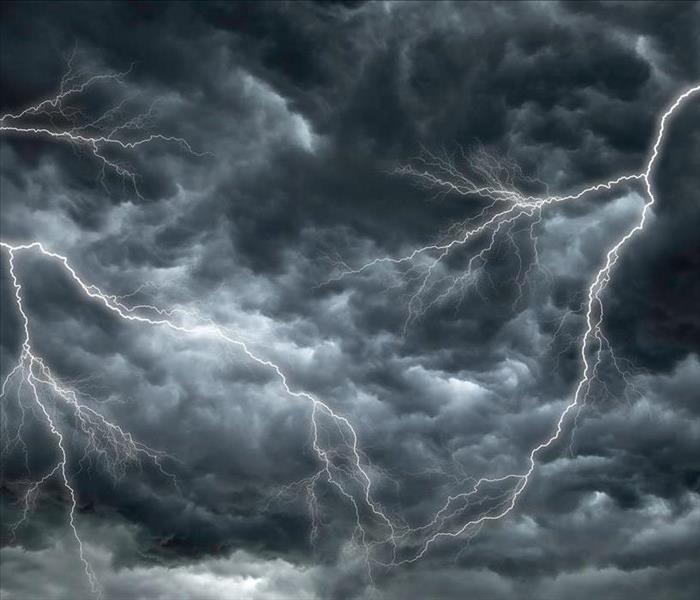 You can minimize the damage after a storm by taking simple steps to protect your insurance coverage.
You can minimize the damage after a storm by taking simple steps to protect your insurance coverage.
Storms can wreak havoc on residential properties; wind and flood damage can lead to significant primary and secondary damage. Even if you have flood insurance, it is crucial you do everything in your power to minimize damage and protect your claim, especially since insurance adjusters will likely be delayed following significant storm surges.
Water and storm mitigation experts in Clearfield, UT, recommend taking a pre-emptive approach to storm cleanup. Instead of waiting for an adjuster, reach out to a remediation specialist to start the restoration process, including:
- Mitigation
- Cleanup
- Restoration
Prevent Further Damage With Mitigation Protocols
If you want to protect your insurance coverage, you will need to take action after a storm. Most insurance companies require policyholders to mitigate further loss and damage in order to receive the total value of their coverage.
If you fail to clean up excess water or take action to minimize the risk of further damage, like mold damage, an adjuster can deny your claim altogether. Thankfully taking action does not have to be challenging. You can contact a mitigation company for assistance. The business will send out a team to assess the damage and take any necessary mitigation measures.
These services commonly work with insurance companies, so it is not unusual for them to understand what is needed to protect your policy and ensure you’re covered. You might want to contact your insurer to explain that you are calling a service, just in case there are any requirements in your policy you need to know about.
Mitigation Services Can Help With Cleanup While Keeping a Record of Loss
Most flood insurance companies will require a loss statement, including pictures and receipts of items damaged in the flooding. While homeowners can be hesitant to clean up after a disaster, worrying the cleanup will undermine the valuation, a mitigation and restoration service will document everything and help you establish a thorough report.
Restoration service will also create an itemized list of the services rendered or recommended, providing you with justification for any and all expenses. Ultimately, using a service helps ensure there is a record of every detail of a disaster for the adjuster when they arrive.
Rebuilding After Storm Damage
Once the adjuster has time to assess your property and claim, the restoration company should have a projection of the total cost of restoration. Your adjuster will be able to review all of the recommendations and determine whether the quote is fair and feasible.
The adjuster can then determine the amount you are covered for and provide approval for the continuation of work. Obviously, as the homeowner, you have a say in which company completes the restoration, but your insurer might have suggestions.
While flood insurance is helpful, especially after a storm surge, the homeowner needs to understand that response times after a flood can be slow. You do not have time to wait for an adjuster. You will need to take action to protect your policy and claim. After a flood or storm damage, make sure to take mitigative steps to protect against secondary damage.
Home Fire Safety Tips
8/19/2021 (Permalink)
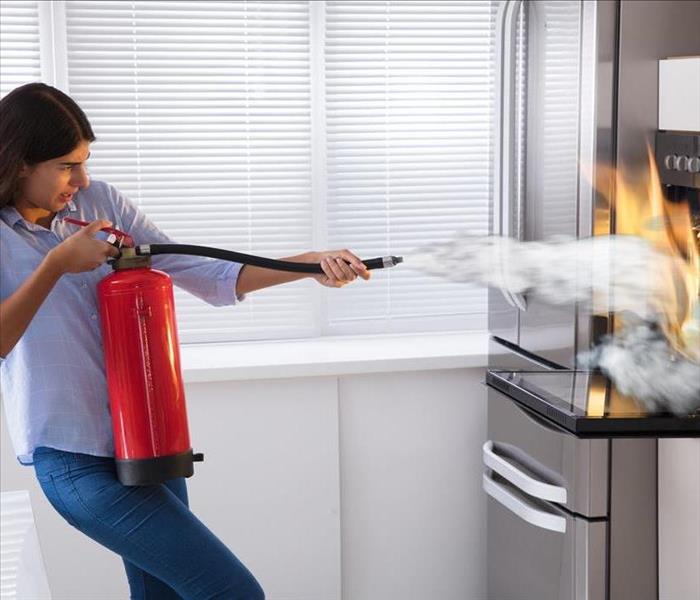 If you can't control the fire with a fire extinguisher in your home in Clearfield, UT, call professionals to avoid further damages.
If you can't control the fire with a fire extinguisher in your home in Clearfield, UT, call professionals to avoid further damages.
Every homeowner likes to believe that his or her house is safe from fires. A fire in your home in Clearfield, UT, can break out much more easily and quickly than you think, though. The smallest error, such as leaving a candle burning too long or forgetting a burner on the stove is on, can ignite a larger flame in no time. When this happens, you should have the security of knowing that every family member knows the proper procedure for handling it. This starts by teaching everyone how to use a fire extinguisher.
The PASS Method
The moment an emergency happens is an unfortunate time to discover that you don't know how to address it. It doesn't do you any good to have a fire extinguisher near your kitchen if you don't know how to use it. Fortunately, all it takes is following an easy four-step process:
Pull - Take the pinout of the top of the extinguisher to unlock it and ready it for use.
Aim - Point the nozzle at the base of the fire.
Squeeze - Apply pressure on the handle to release the agent inside the extinguisher.
Sweep - Slowly but steadily move the stream from the nozzle back and forth along the base of the fire.
If done correctly, the PASS method should put out most small fires that occur in your home. If the flames still persist after you have emptied the canister of the fire extinguisher, don't reach for another one to try again. It's time to let the professionals take over. Call 911 and evacuate the house.
The Right Extinguisher
Not all fires are the same, so it makes sense that different extinguishers would need to hold different types of agents. When you are choosing the right fire safety equipment for your home, look at the ratings. An "A" rating means it is most useful for trash, paper, and wood fires. A "B" rating means that it contains an agent that works best on flammable liquids. A "C" rating is what you need for areas where electrical fires are possible. According to fire damage mitigation experts, the best extinguisher to fight a kitchen fire will have at least a "B-C" rating, if not all three.
The Best Prevention
One of the goals of fire safety is to prevent as much fire damage to your home as possible. Of course, the best prevention is to avoid circumstances that cause the fire in the first place. Since the kitchen is one of the most common places where home fires occur, it's imperative that everyone who uses the kitchen understands basic safety measures. For example, remember to turn the oven and stove off when you're not using them. Don't keep items on top of the stove that are likely to ignite. Clean up oil and grease messes as soon as they occur.
Having a fire extinguisher handy in every area of your home is an essential part of any solid fire safety plan. If you can't prevent a fire altogether, knowing how to handle it quickly and efficiently is the next best option.
What Is Category 1 Water Damage?
8/11/2021 (Permalink)
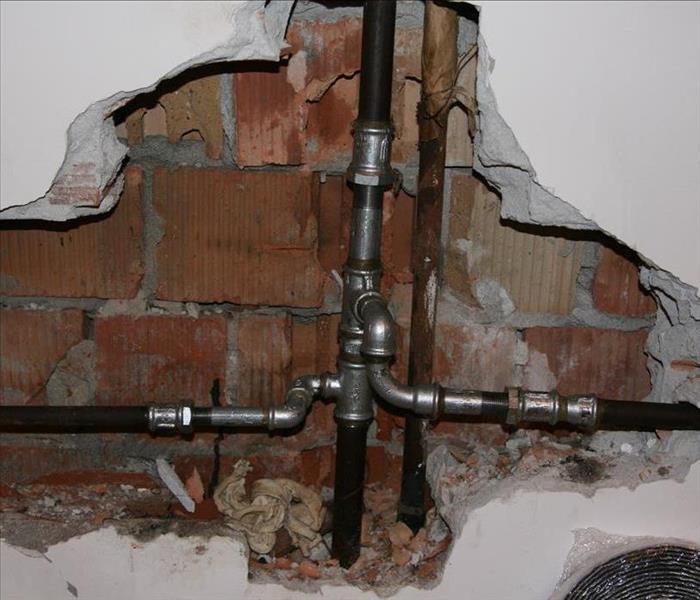 Category 1 water damage in a Clearfield, UT, building.
Category 1 water damage in a Clearfield, UT, building.
When you have water damage in your building, it is important to clean it up and dry your property out as quickly as possible to avoid additional damage. The type of restoration that needs to be done can vary depending on whether the damage is from clean water, grey water, or black water. Different types of water damage are classified according to category.
What Category 1 Water Damage Is
Category 1 water damage is usually the easiest type of water damage to deal with because it is water from a clean source. There are multiple examples of sources of category 1 damage:
- Broken pipe
- Broken supply line
- Overflow from a clean sink or tub
- Some appliance leaks
The distinguishing feature of this type of water damage is that it doesn't contain harmful bacteria or chemicals that require protective gear when cleaning it up.
What To Do When You Have Category 1 Water Damage
The first thing to do is shut off the source of the clean water. If the water is coming from a broken pipe, shut off the water to your house. If it is an overflowing sink or tub, turning off the tap should work. If you have an appliance that is leaking, unplug it, shut off the water and disconnect the supply line. You may need to place towels around the base to soak up any water that is still coming out.
Once you have shut off the source of the water, clean up the water damage as soon as possible. You can use a mop and bucket, sponges, or a wet/dry vacuum. Wet carpeting can be difficult to fully dry and may need to be replaced. If there is a lot of water damage, you may want to contact a water restoration company in Clearfield, UT. Some types of water damage may be covered by your insurance company. Contact your insurance professional to find out if you should file a claim.
Why It is Important To Dry Your Property Quickly
Mold and mildew thrive in wet conditions and can begin growing in 24 to 48 hours after water damage. The faster you can dry out your property, the less likely you are to experience mold growth. This may also help you avoid other problems, such as warping and rot. Additionally, standing water that sits for too long can become contaminated and may require professional cleaning services to be safely removed.
How You Can Avoid Future Problems
Avoid overflows by not letting sinks and tubs run while unsupervised. Have your appliances regularly maintained. Check for signs of a water leak, such as musty odors, unusual sounds, water pressure issues, stains, discolored water, or unexplained increases in your water bill. Fix or replace leaking pipes promptly. Insulate your pipes in cold weather to avoid potential damage caused by freezing temperatures. Drain your pipes if your building will not be in use for extended periods.
Water damage from clean water is the easiest type of water damage to deal with. However, it still requires prompt attention to avoid unnecessary additional damage to your property.
How To Stay Safe After a Flood Invades Your Home
7/15/2021 (Permalink)
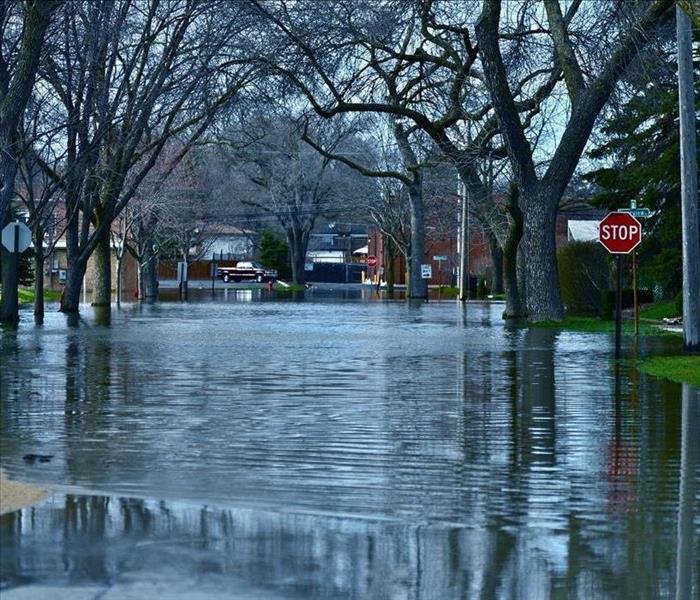 Street flooded in Clearfield, Utah
Street flooded in Clearfield, Utah
Flooding is a disaster that can happen in virtually any area, given the right set of circumstances. Whether from a hurricane that affects hundreds of miles of land or heavy rain that rushes into your basement, it can have devastating effects on the property, causing safety issues for you and your family. Familiarize yourself with the steps for flood safety before your home in Clearfield, Utah, is in a flood.
1. Investigate for Property Damage
Investigate your property for damage, such as downed power lines and structural harm, such as foundation cracks.
2. Check the Water Supply
You must check your water supply before you use it to make sure it's not contaminated. To be safest, check with your water supplier to make sure it's safe for drinking. Flood safety experts will advise that until you know for sure, you can boil water when you need clean water for drinking, washing, making ice, or preparing food.
3. Wear PPE for Cleanup
Before you begin cleaning, it's vital to wear personal protective equipment to keep you safe and avoid cross-contamination to unaffected areas. Safety glasses, a respirator, latex gloves are the minimum PPE you should wear.
4. Dispose of the Unsalvageable
Unfortunately, there could be a lot of unsalvageable property, and it's crucial to remove them from the area as soon as possible. This action will make more room for flood damage restoration professionals to operate. Food, medications, and cosmetics that have come in contact with the water must be thrown away. Soaked carpet and sections of drywall must be removed. Also, any saturated porous objects, such as wooden or upholstered furniture that can't be cleaned and thoroughly dried within 48 hours will need to be thrown away.
Being aware of flood safety methods can keep you safe and minimize property loss. Prepare for the possibility of the unthinkable by remembering these essential safety tips.
5 Places To Check for Mold Growth in Your Home
6/28/2021 (Permalink)
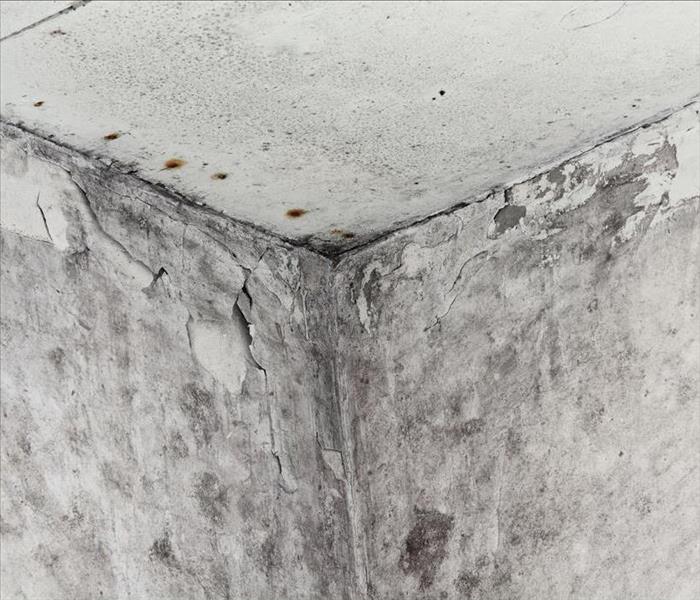 Mold hides and growth easily in Clearfield, UT homes.
Mold hides and growth easily in Clearfield, UT homes.
Mold spores exist virtually everywhere, so it's no surprise that it's regularly found growing in various areas indoors. Sometimes you can tell when there's mold in the area due to its musty odor. However, it's very good at hiding so that you may not find it until it's out of control. Here are five places where mold damage commonly hides in homes:
1. Basements
Many basement areas are prone to mold growth; basements tend to have more humidity and moisture than other areas. Look for signs of mold or mildew growth around foundation cracks, windows, vents, around a sump pump, and around pipes and ductwork. Ideally, water damage restoration professionals will inspect the area; leaks and condensation can quickly cause mold to grow.
2. Bathrooms
There are several places to look for mold in bathrooms. Pipes, cabinets, shower curtains, and doors, bathtubs, showers, sinks, toilets, counters, tiles, flooring, and even bathroom rugs are the perfect havens for mold. In addition, storage caddies and sponges can also harbor mold.
3. Attics
Attics often contain a big part of your home's ventilation system, so having mold in the attic can lead to a huge problem. This is because mold spores can spread through the rest of the house through the ventilation system. Look for mold damage around the roof, especially in the case of leaks (e.g., from the water heater, furnace, or vents).
4. Laundry Rooms
Water connections to the washing machine can grow mold. Leaving damp clothes in the washer or dryer can also begin growing mold quickly. Even dryer lint buildup can increase your chance of mold and mildew growth.
5. Behind Walls
Mold can begin growing behind walls without you knowing it exists. Always look out for leaks or excess moisture on walls. Mold can grow on and through the drywall.
The key to avoiding mold damage in your Clearfield, Utah, home is to keep moisture and humidity down. Make sure you're free of leaks, adequately insulated and ventilated. If you find that your relative humidity is high in your home, consider using a dehumidifier.
Why You Should Only Trust IICRC Certified Technicians
6/28/2021 (Permalink)
 A certified and expert work team provides the best experience and the assurance that your home is in the hands of professionals.
A certified and expert work team provides the best experience and the assurance that your home is in the hands of professionals.
You shouldn’t let just anybody into your home to clean up after a water disaster. The Institute of Inspection, Cleaning and Restoration Certification (IICRC) is a recognized certification for the cleaning and restoration industry. The non-profit presents the gold standard in mitigation and cleaning techniques. If you want a technician who promises the best disaster recovery possible, find a business that is IICRC certified in Clearfield, Utah, because these businesses promise a few things above other non-licensed or certified companies.
1. A Correctly Trained Crew
A company with a mitigation certificate is more than a brand with a logo; it is a business with highly skilled employees. Certification is only obtained by those businesses that ensure the training and continued education of their technicians. The training includes:
- Fire restoration
- Water restoration
- Mold mitigation
- Carpet and upholstery cleaning
- Crew training
- Applied structural drying
- Restorative drying for loss control
2. Professional Connections and Management
Certified franchises and technicians only work with the best. The company will have a list of other approved technicians and services they work with, allowing customers to feel comfortable in the project. Additionally, franchises, such as SERVPRO, work with national account managers, helping homeowners, technicians, and insurance companies coordinate throughout the project.
3. Peace of Mind
Aside from dealing with a trained crew, working with certified and licensed experts provides peace of mind. You know the work being done on your home is guaranteed. If a problem arises related to the original issue after the cleanup and restoration, the company will stand by their work, ensuring you worry-free nights.
An IICRC certificate is more than a piece of paper or symbol on a business card. It is a promise that the professionals with the credentials understand the cleaning, mitigation, and restoration process. Your home is not a place to allow just any repair technicians; only the best should be given the privilege to work where you sleep.
4 Basic Steps To Protect Buildings From Storm Damage
6/22/2021 (Permalink)
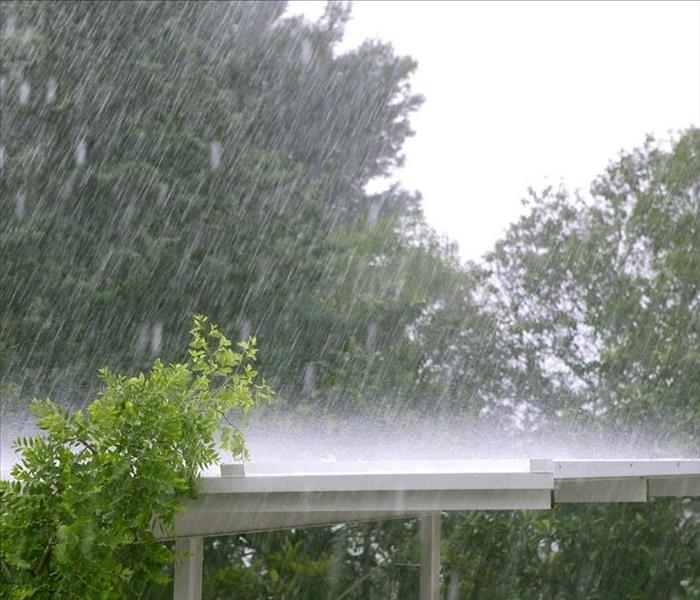 Heavy storms can damage your roof.
Heavy storms can damage your roof.
Thunderstorms happen in every part of the country and may bring winds at more than 100 mph. The best way to protect your Clearfield, UT, business is to take preventative steps before storms head your way. A loose window frame or a very small roof leak could lead to significant problems when exposed to high winds.
Simple Steps to Avoid Roof Leak
Schedule and Carry Out Routine Roof Inspections
Look for obvious signs of damage, such as bubbles, cracks, missing shingles, tears, punctures, uneven distribution of roofing materials, and other signs of wear and tear. It's also important to check the gutters for the accumulation of leaves, dirt, sticks, and other debris. Make sure that roofing materials and gutters are attached securely enough to resist the powerful force of windstorms.
Check Doors and Windows
During visual inspections of doors and windows, pay special attention to hardware. The brackets, bolts, hinges, and other hardware must be secure enough to remain connected in the face of water and wind. If you notice dents, warping, rusting, or other damage, contact property damage repair and replacement professionals to make sure your buildings are secure.
Protect Exterior Buildings and Equipment
During good weather, maintain your landscape to prevent windblown branches from causing a damaged roof and possible new roof leak. When storms threaten, gather any equipment, supplies, or furniture you keep outside and secure them in a shed or other appropriate shelter.
Understand Your Insurance Coverage
Before your property is exposed to any damage, make sure you understand what your policy covers. For example, do you have a business continuity plan? Your insurance provider may also be willing to help you develop an emergency preparedness plan with tips such as keeping tarps and plywood available to board up damage while waiting for repair professionals.
Thunderstorms can cause a lot of problems around your building, even if you don't have an existing roof leak. Make sure you know how to prevent or at least minimize property damage.
4 Tips for Taking Care of Your Home’s Smoke Alarms
5/25/2021 (Permalink)
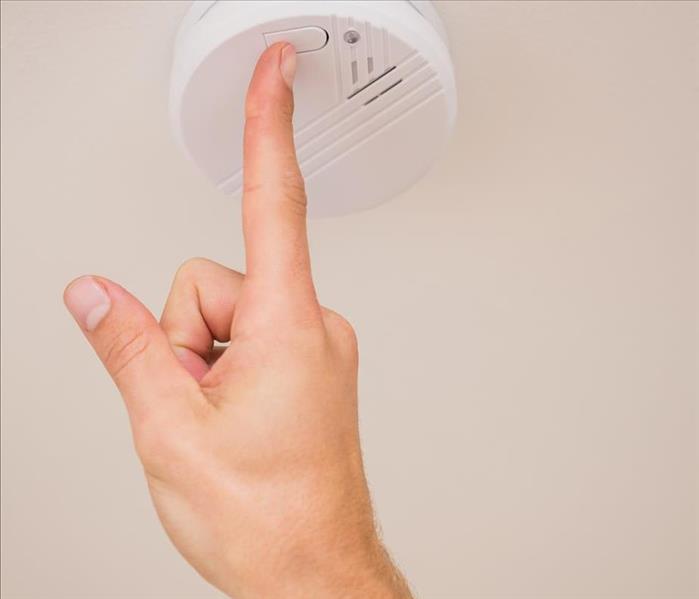 Take care of your home's smoke detector.
Take care of your home's smoke detector.
Often, daily life gets in the way of remembering everything that comes with managing a home. These routine tasks must include smoke alarm care. Keeping your units functioning properly could one day mean the difference between incurring only minimal fire damage and losing everything. Therefore, it's vital to inspect and maintain them regularly. Consider these tips for taking care of a smoke detector.
Tips for Taking Care of a Smoke Detector
1. Maintaining the System
Dust or vacuum your alarms regularly to free the unit of dust and other contaminants. These particles can interfere with the alarm's detection ability.
2. Testing the Units
Manufacturers of all types of smoke alarms recommend testing them at least once each month to ensure they're functioning correctly. You can try them by pressing the test button on each unit. You can go a step further and test them by introducing a small amount of smoke near them.
3. Replacing the Batteries
A smoke detector that runs on a nine-volt battery should have the battery replaced at least once a year. A smoke alarm that utilizes a "long-life" lithium battery doesn't have the capability of replacing the battery. Therefore, the unit itself must be replaced (consult the manufacturer's instructions). An alarm that's hardwired into the home's electrical system has a battery backup. You should replace the backup battery at least once a year.
4. Replacing the Units
Whatever type of smoke detectors you have in your home in Clearfield, UT, fire damage experts recommend replacing the units themselves every 10 years from the manufacture date. You can find this date on the back of the device.
When you're checking off the list of routine home tasks, don't forget smoke alarm maintenance. Taking these proactive steps could prove to be one of the most important jobs you perform if the worst happens. Take care of your alarm system to ensure the welfare of your family and home.
Tips for Addressing Flooding in Your Building
4/15/2021 (Permalink)
Water damage can wreak havoc on your commercial building. Knowing what to do before, during and after a storm ensures that your business is interrupted as little as possible. When your office or warehouse in Clearfield, UT, floods, there are several things you need to do to get your building back to normal.
3 Tips for Addressing Flooding in Your Building
1. Prepare for the Storm
The best defense is solid prevention. You may not be able to prevent all the damage that a heavy storm can bring, but you can minimize the amount of contaminated water that gets into your building. Black water carries brings a lot of things with it:
- Bacteria
- Dirt
- Debris
- Chemicals
To prevent as much damage as possible, use sandbags or other types of barriers, particularly around doors or other entry points to block floodwater from getting into your building. Incorporate trenches into your landscaping plan that are designed to direct excess water away from your building. Have the whole building from the roof to the foundation inspected regularly to identify trouble spots.
2. Avoid Flooded Spaces
When the building starts to flood, it's natural to want to do whatever you can to prevent as much water damage as possible. Charging directly into standing water is a bad idea, though. You don't know what is in contaminated floodwater. No one should enter it until he or she dons the appropriate protective gear and is taking every possible precaution.
3. Hire a Mitigation Team
Once the storm passes, the first call you make should be to certified flood mitigation experts. The team can arrive within hours of your call and assess what needs to be done. Technicians remove water, repair damage and test your building before and after mitigation to make sure that it has been thoroughly decontaminated.
Storm season can be unpredictable. You may not be able to prevent all the water damage to your building during a storm, but knowing the appropriate next step to take is crucial to efficient mitigation.



 24/7 Emergency Service
24/7 Emergency Service





































